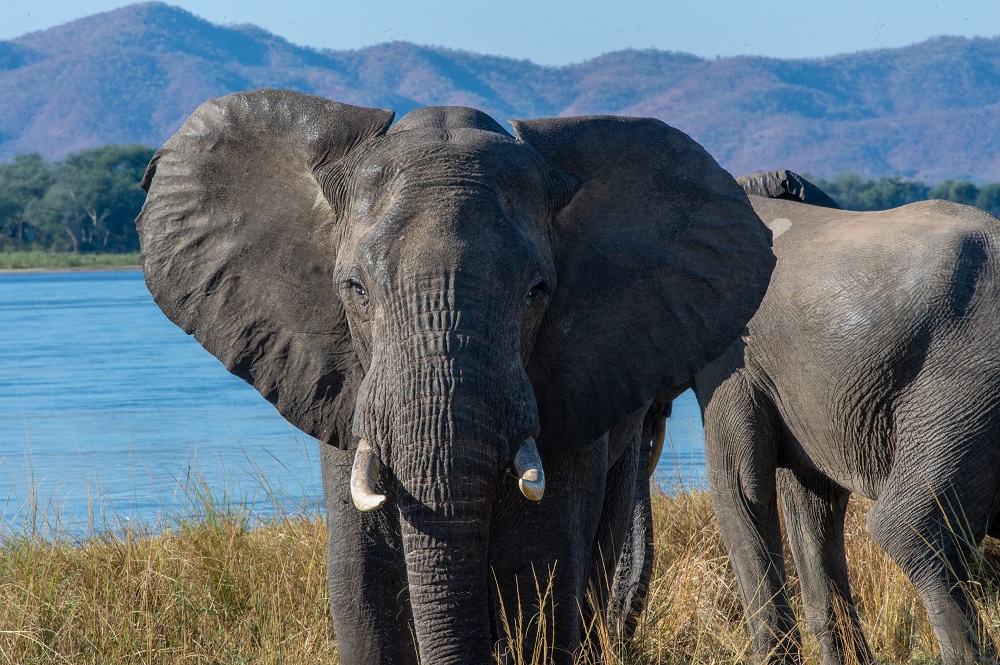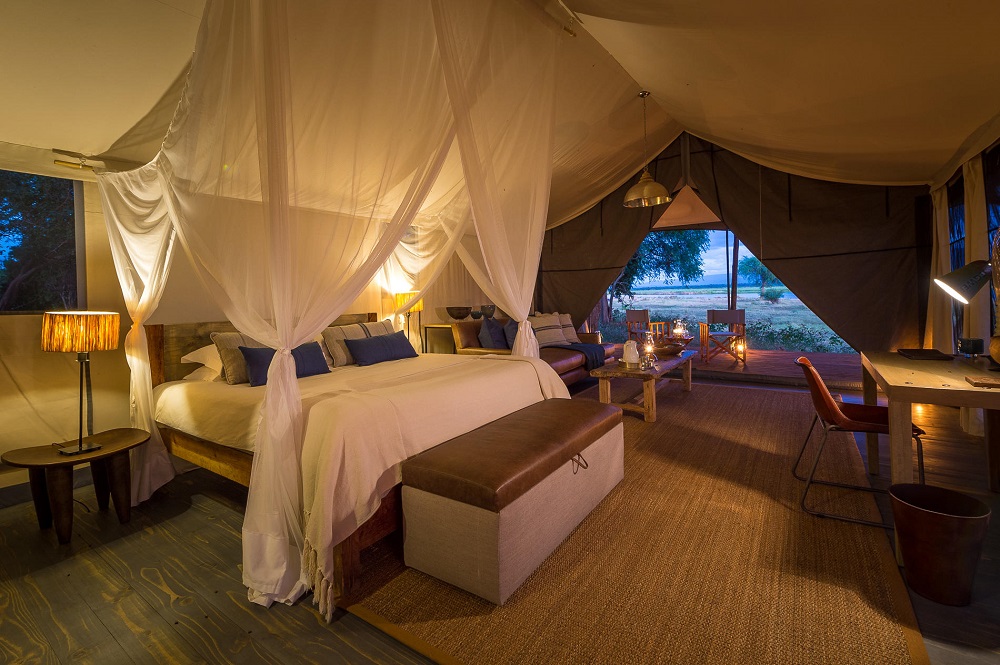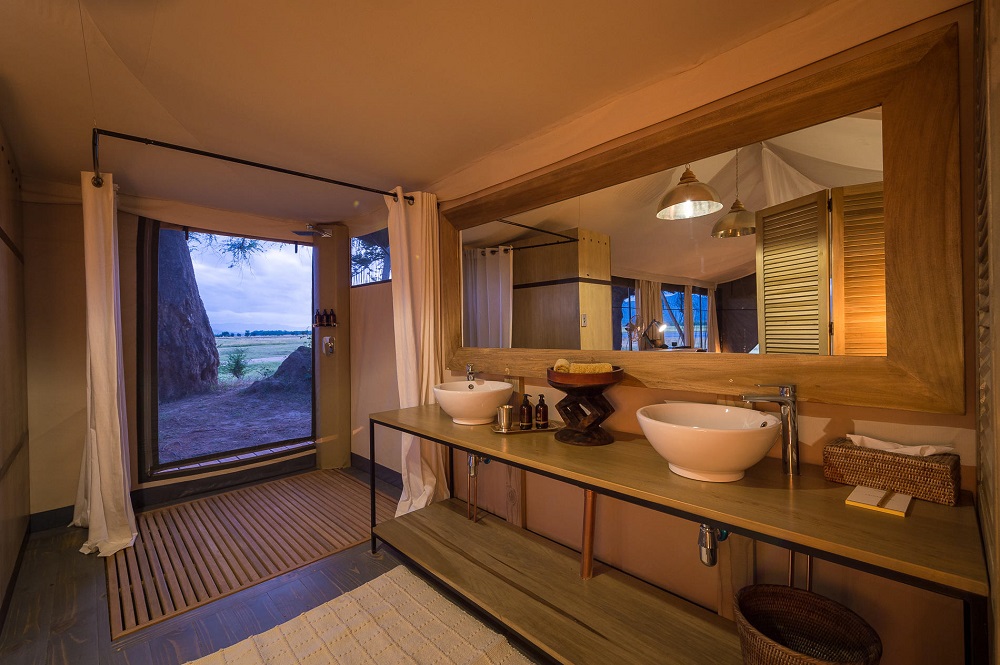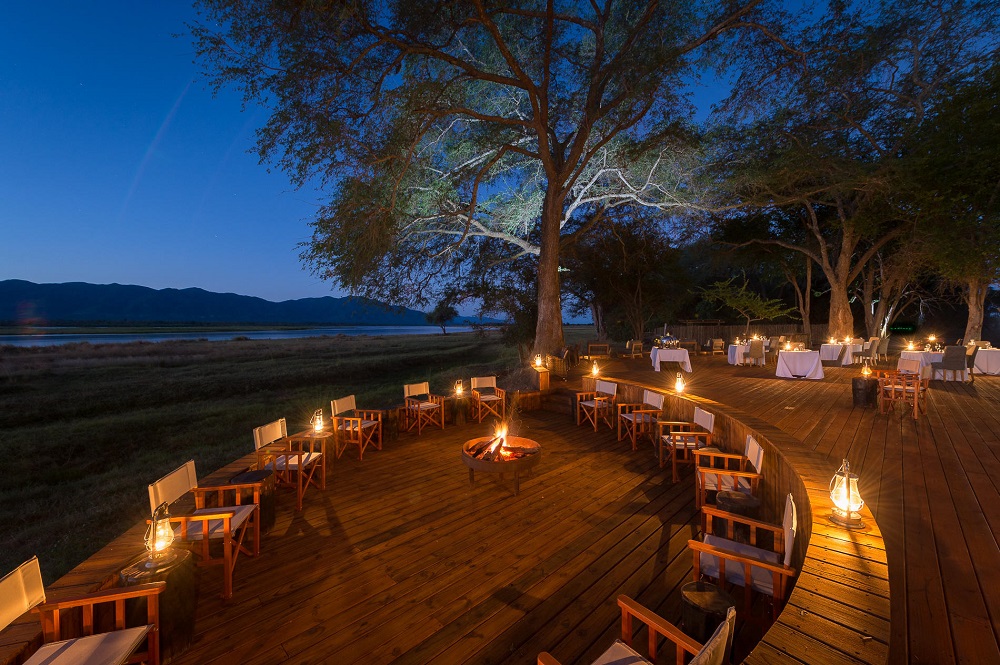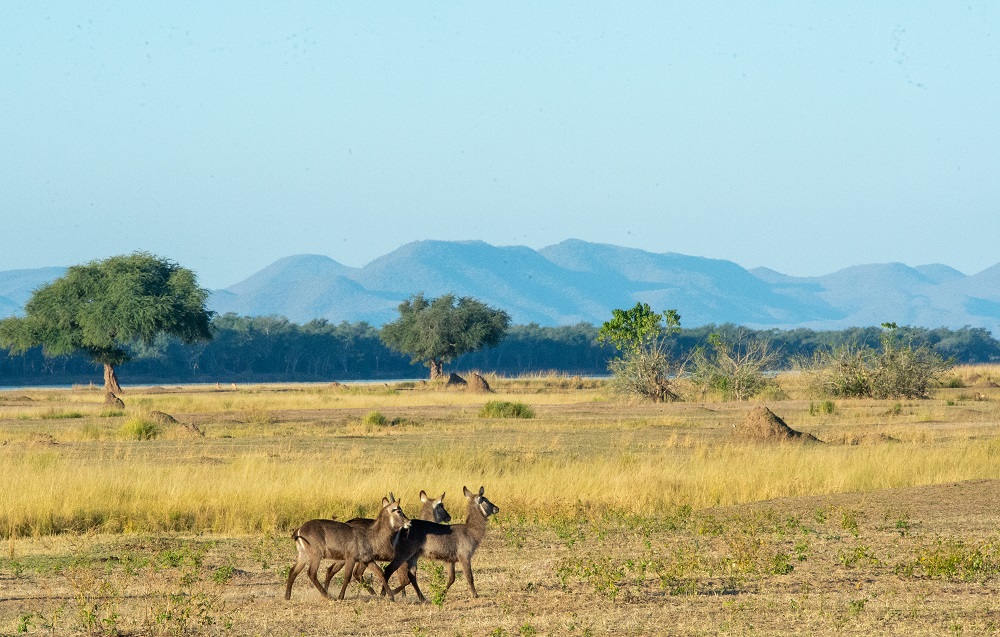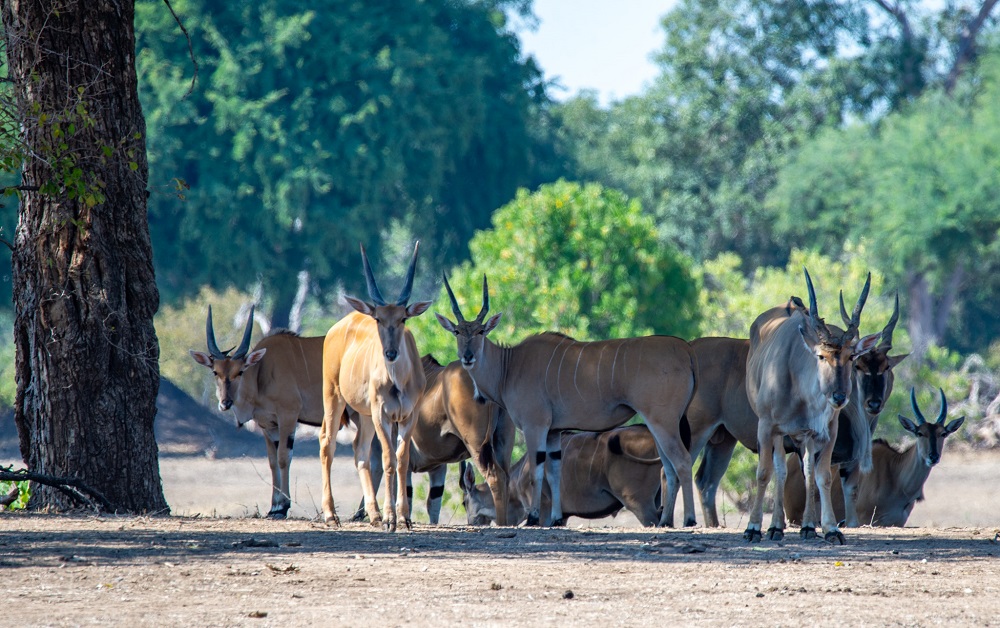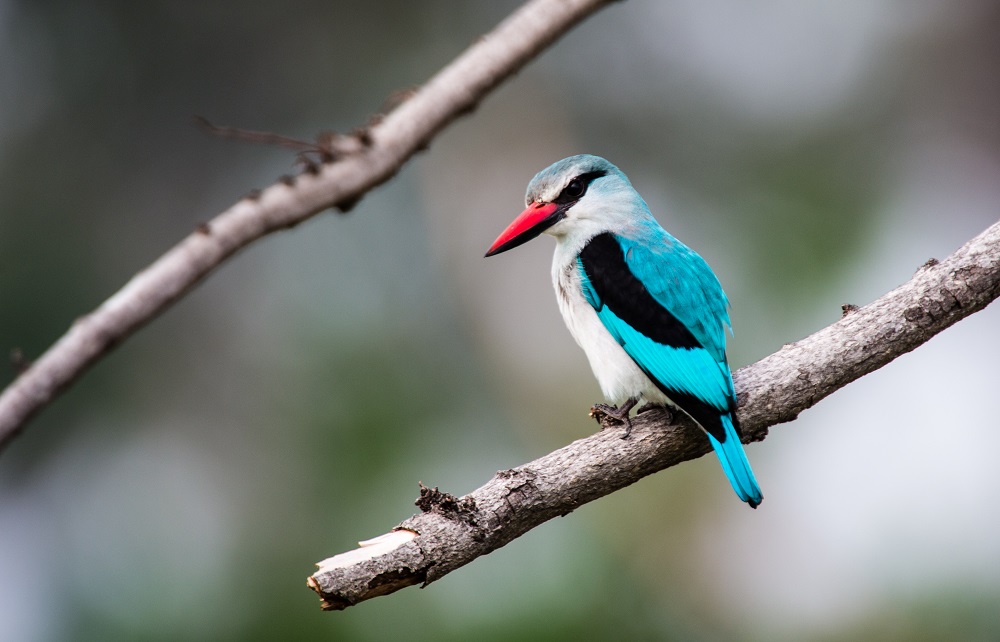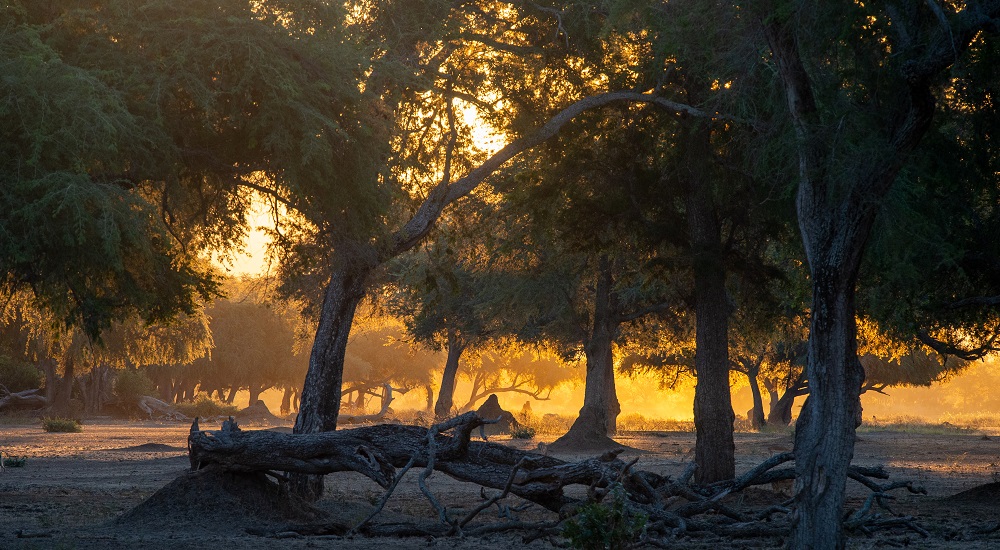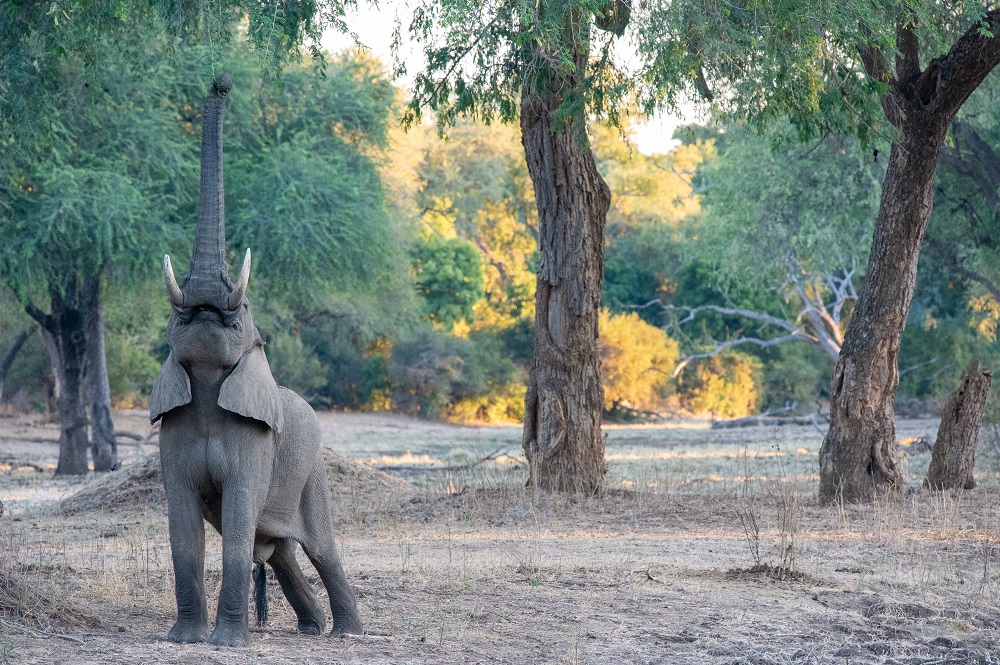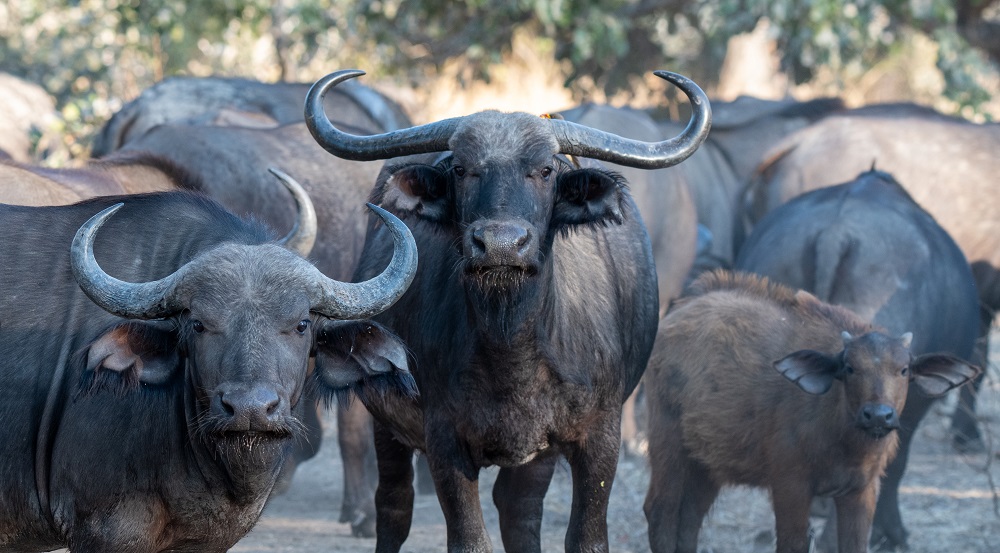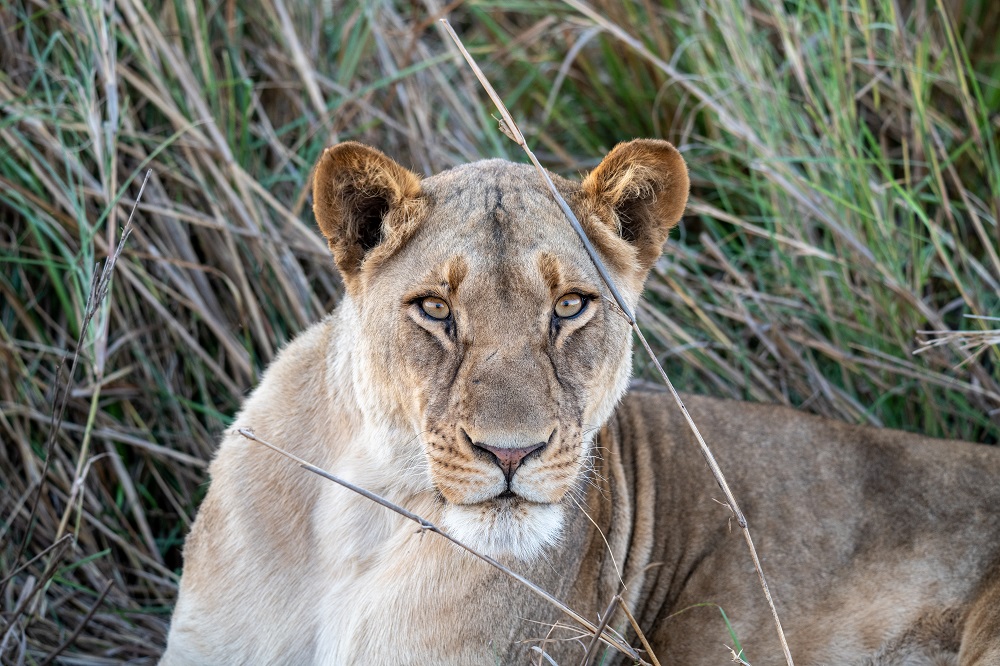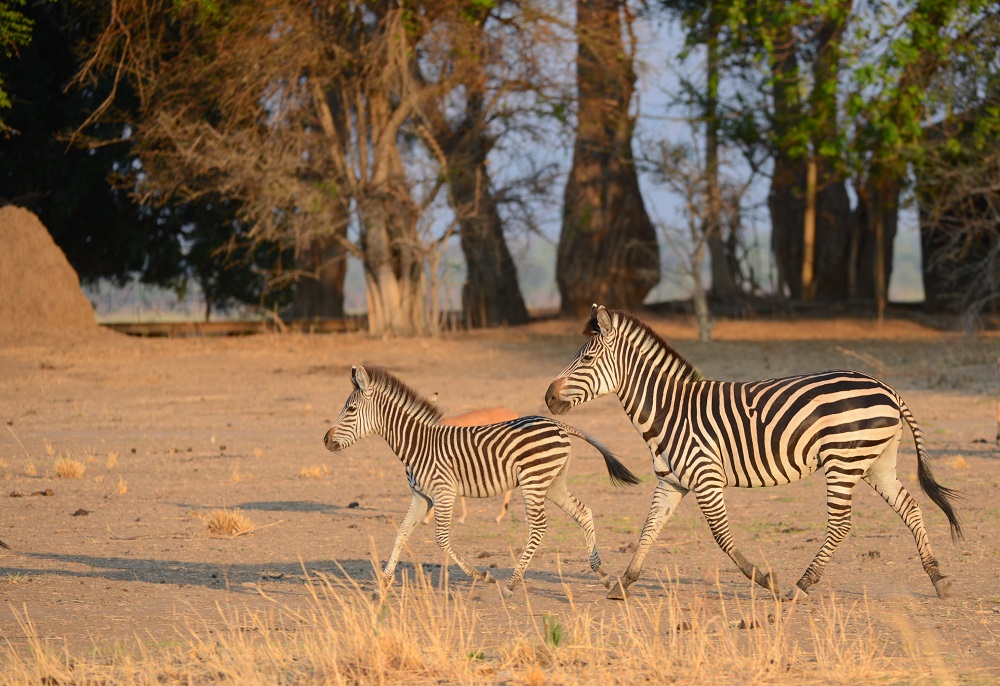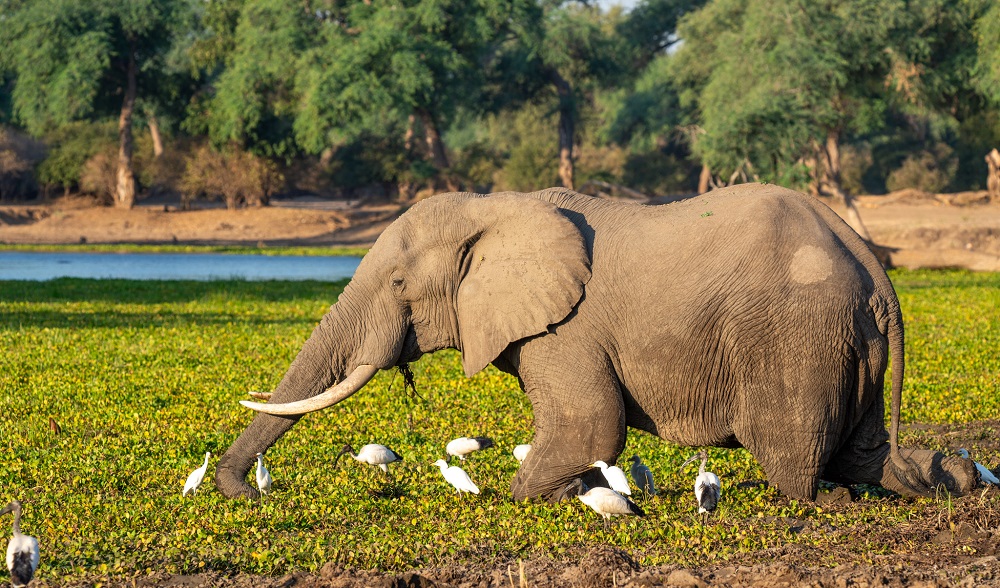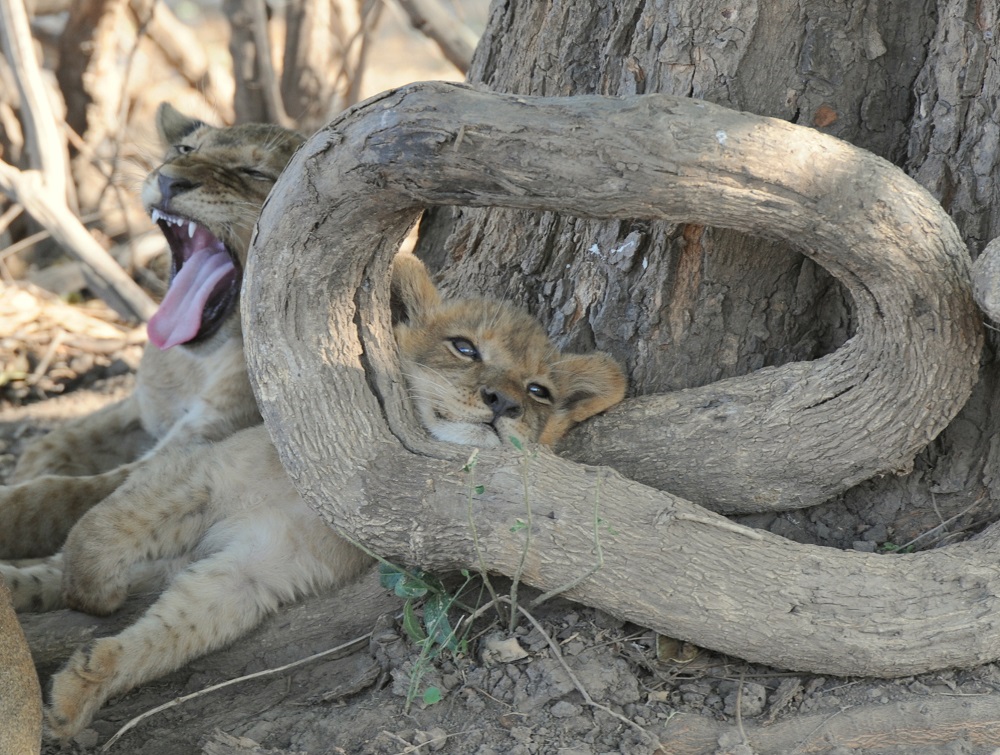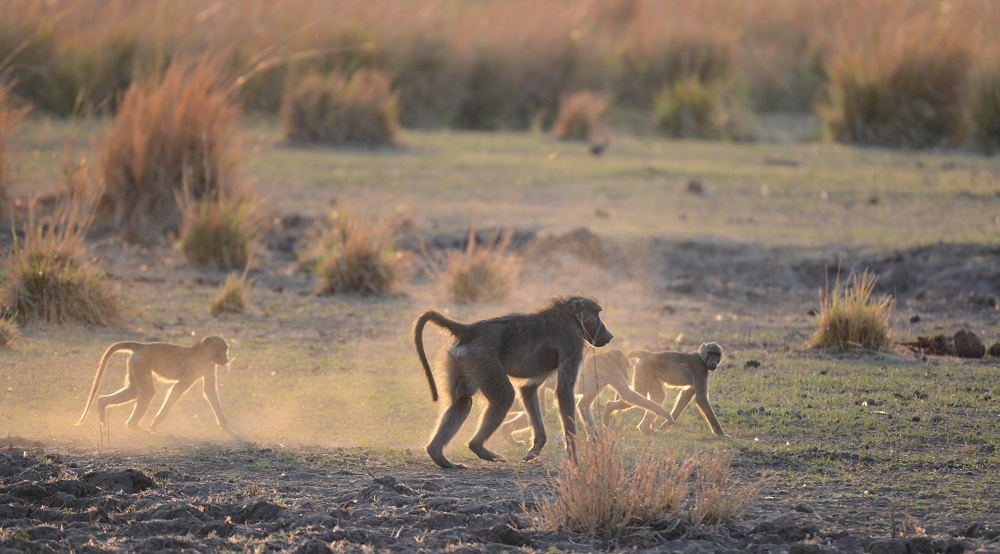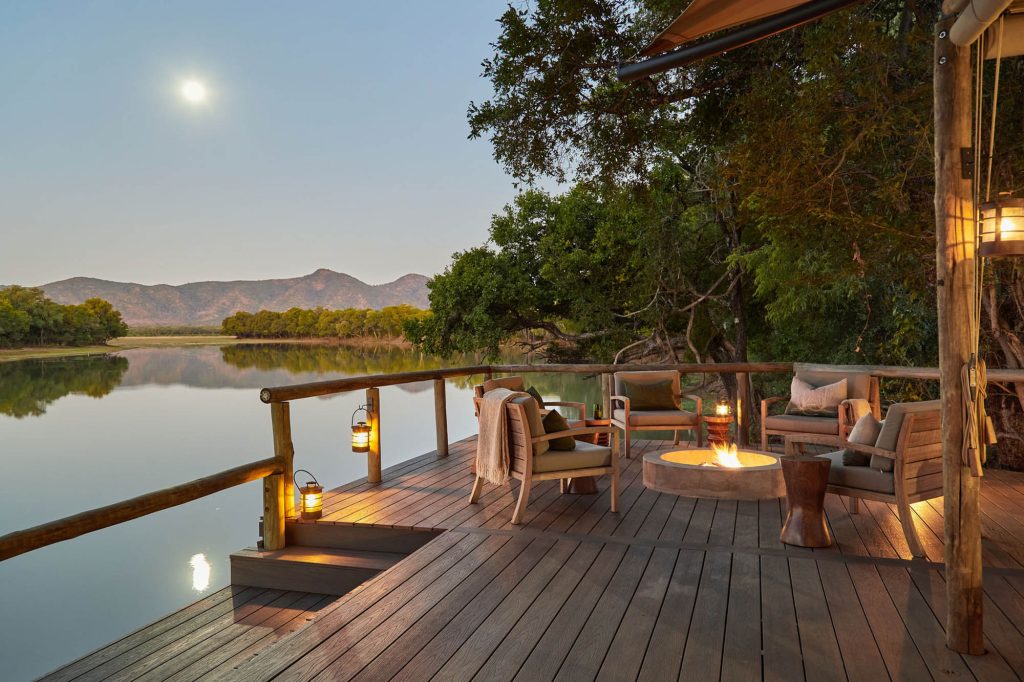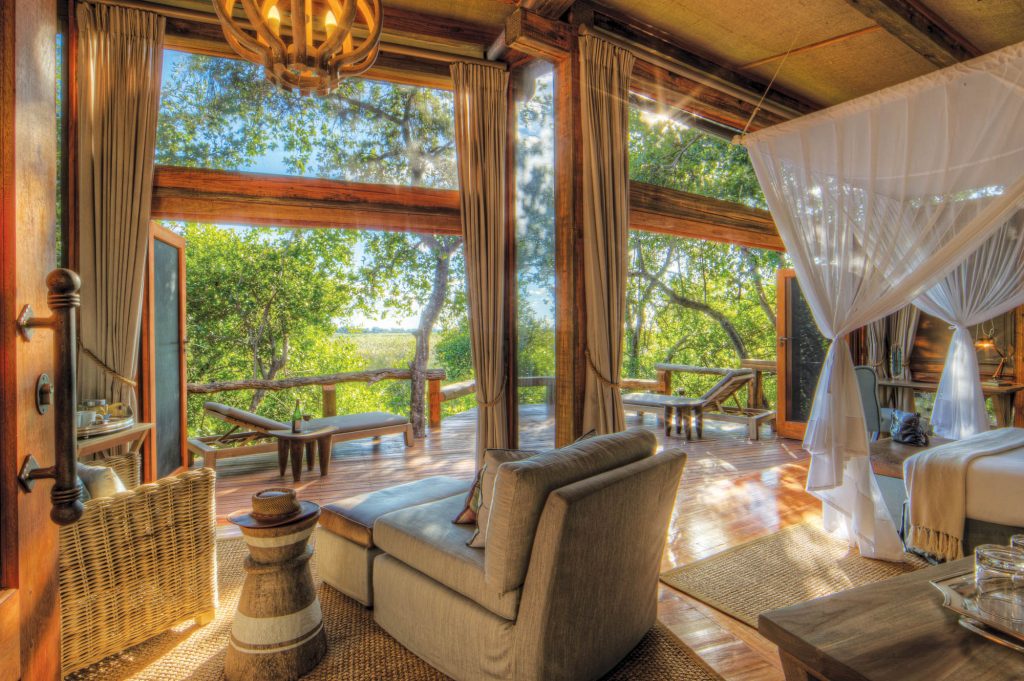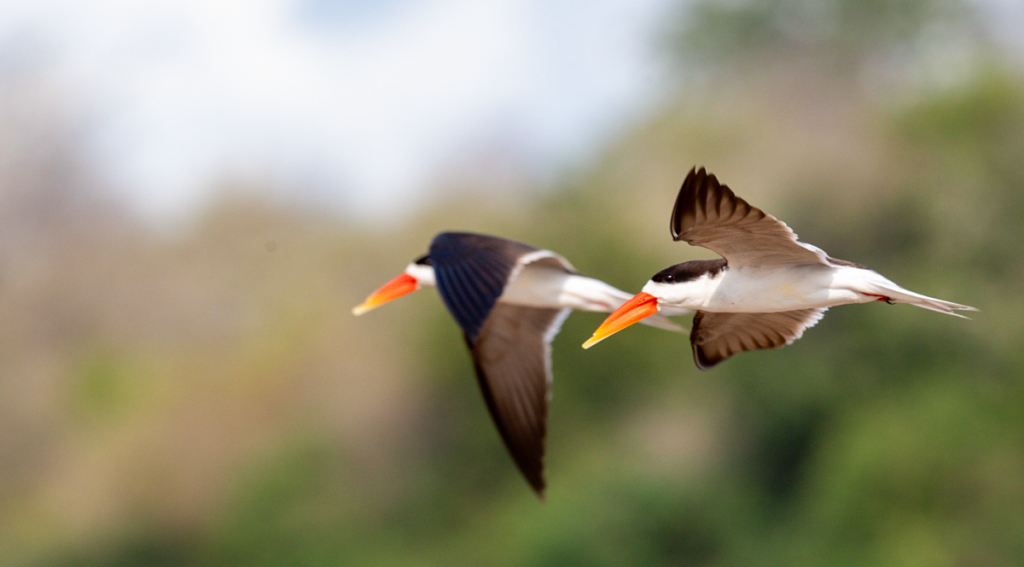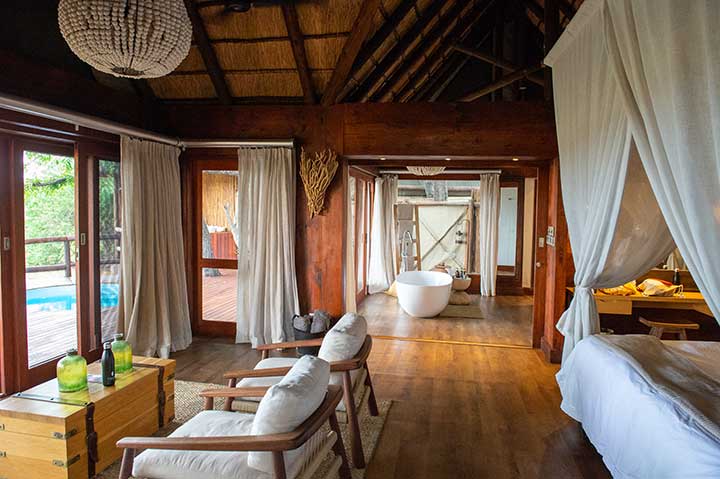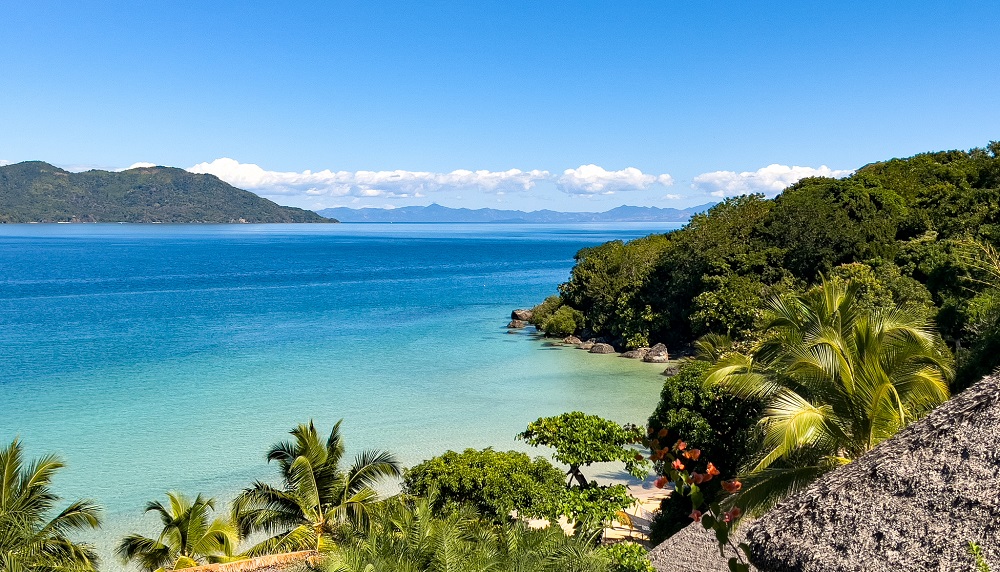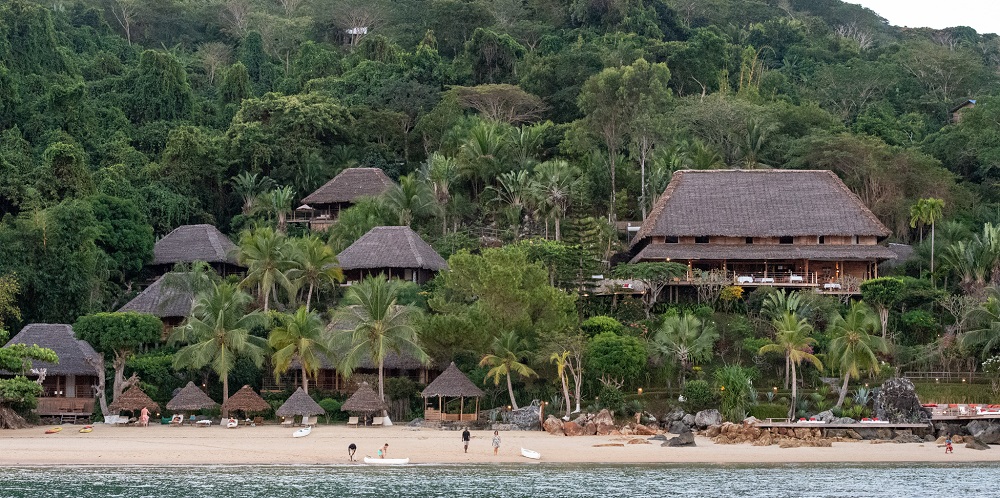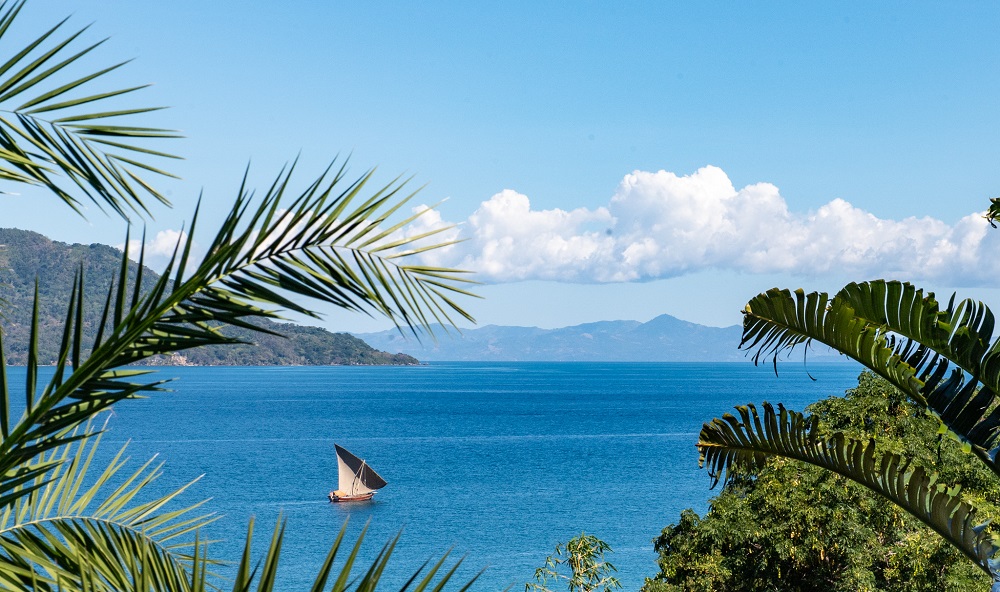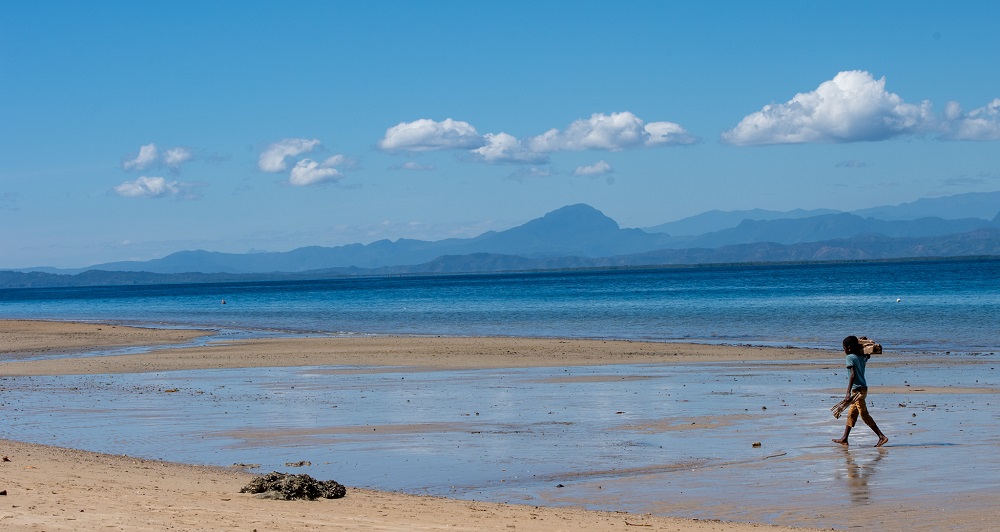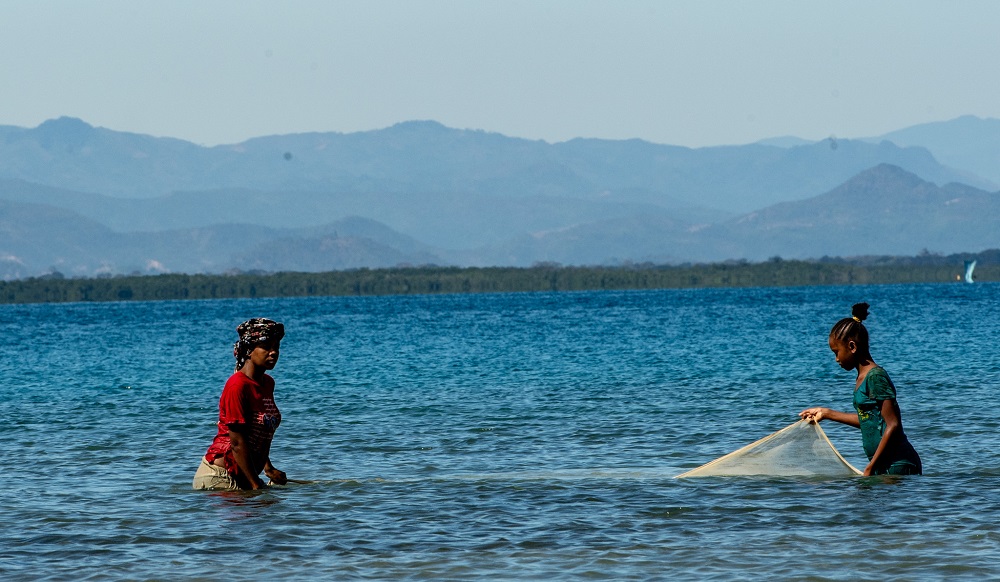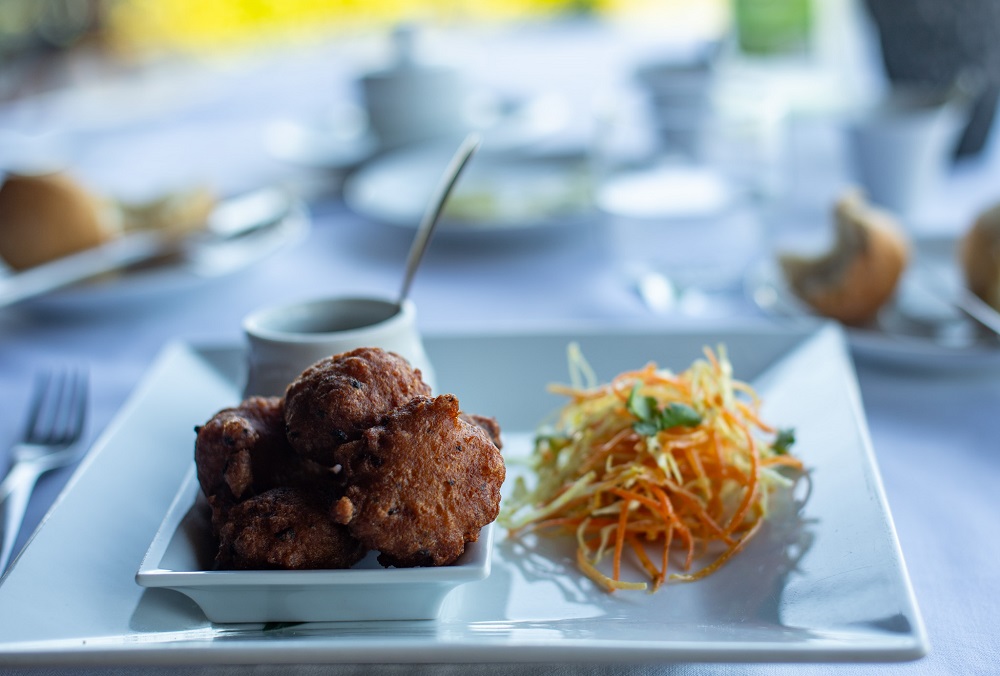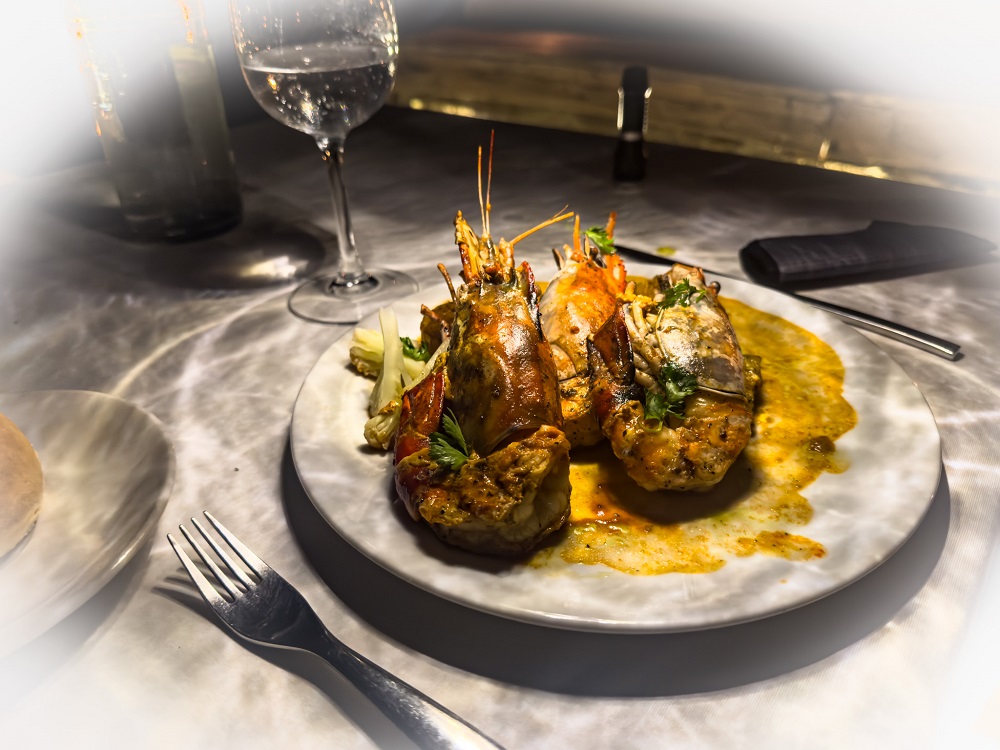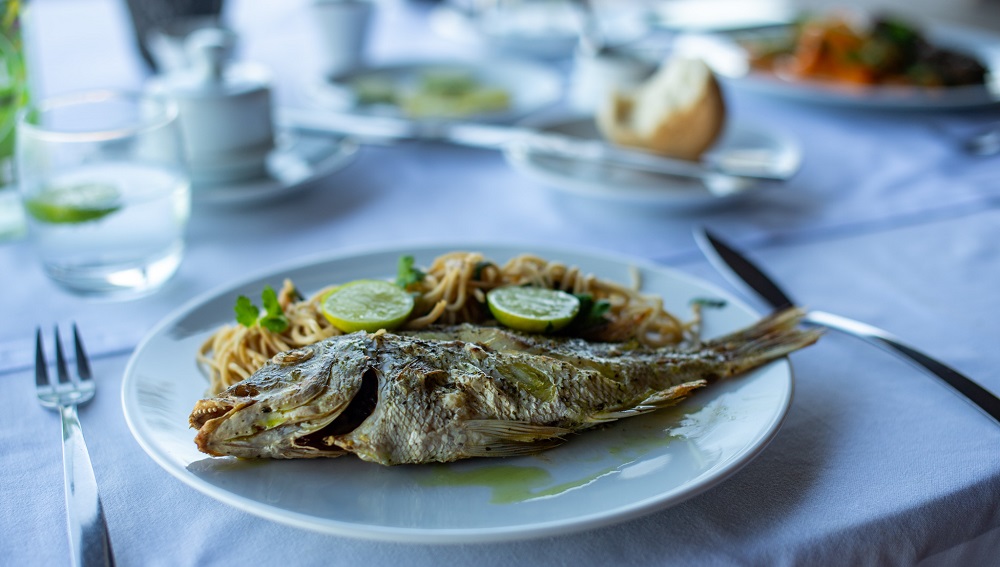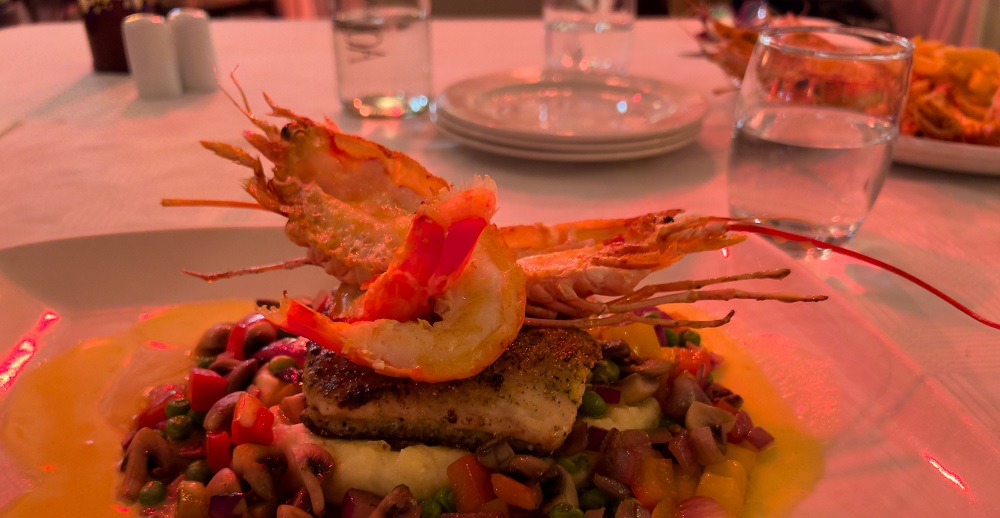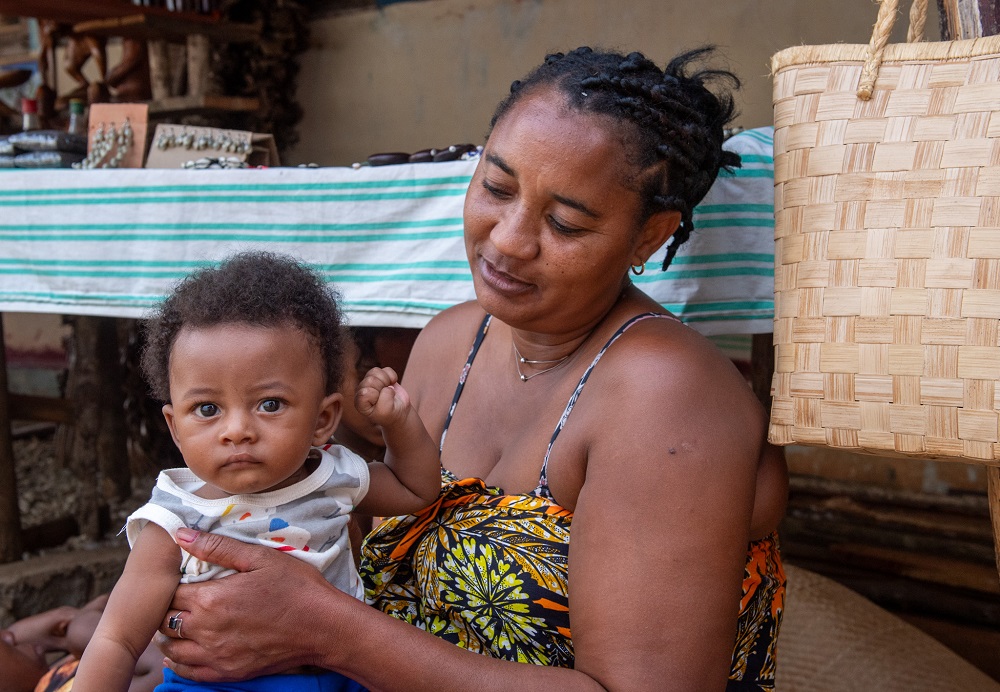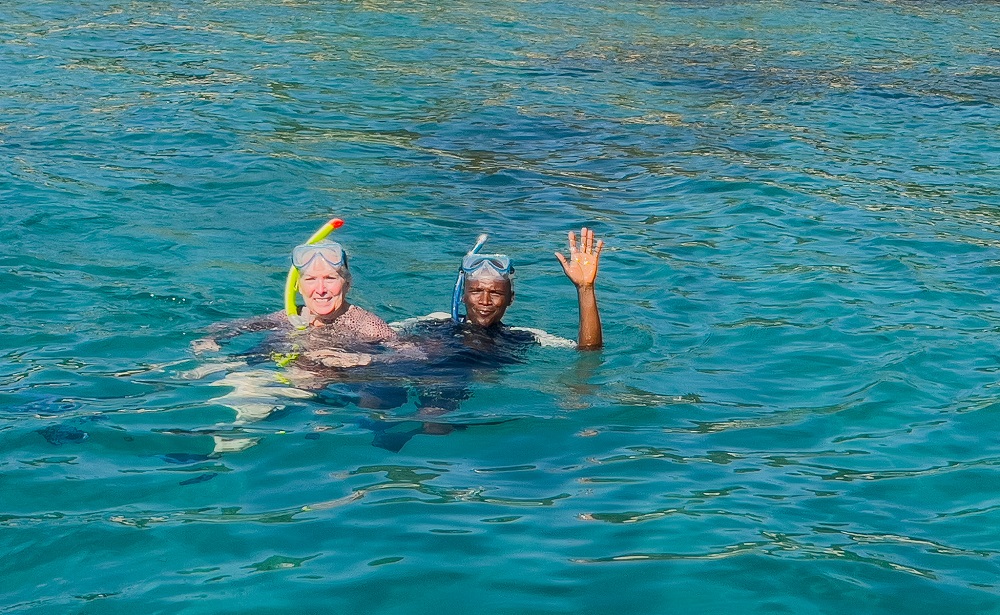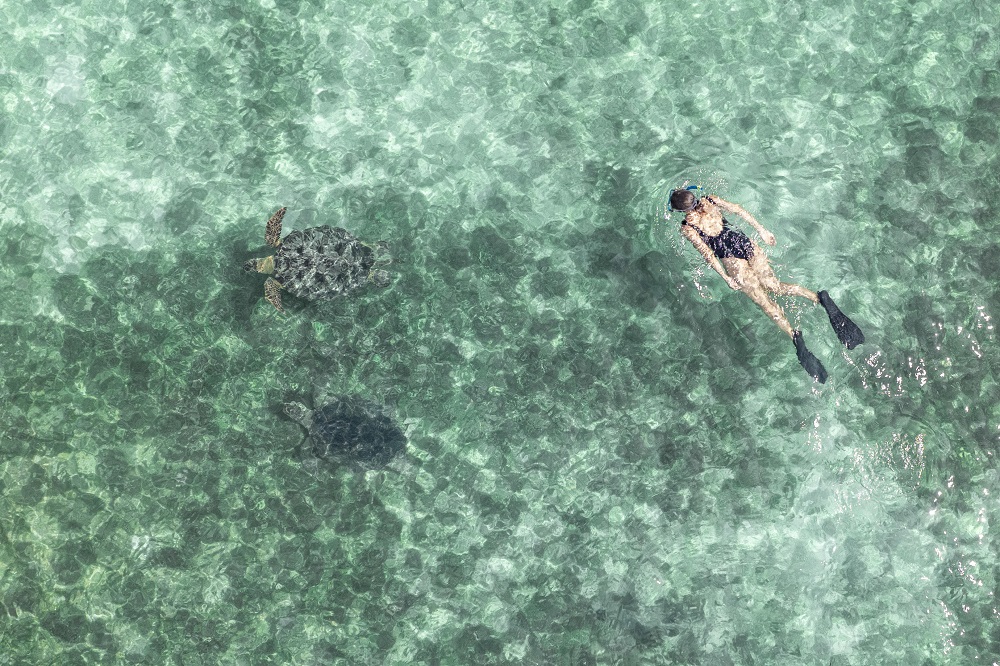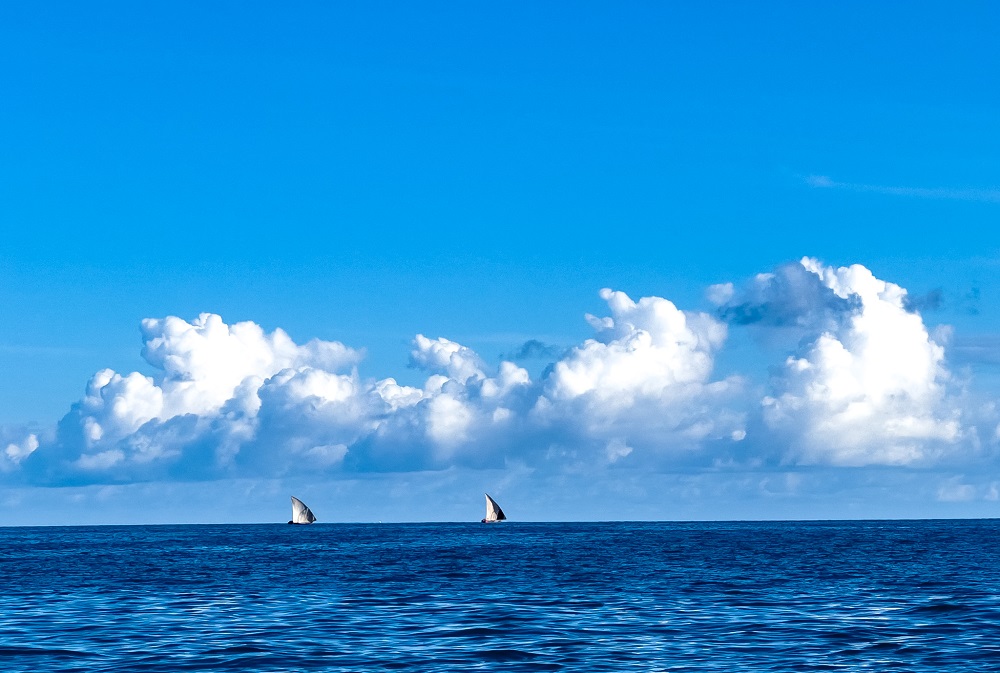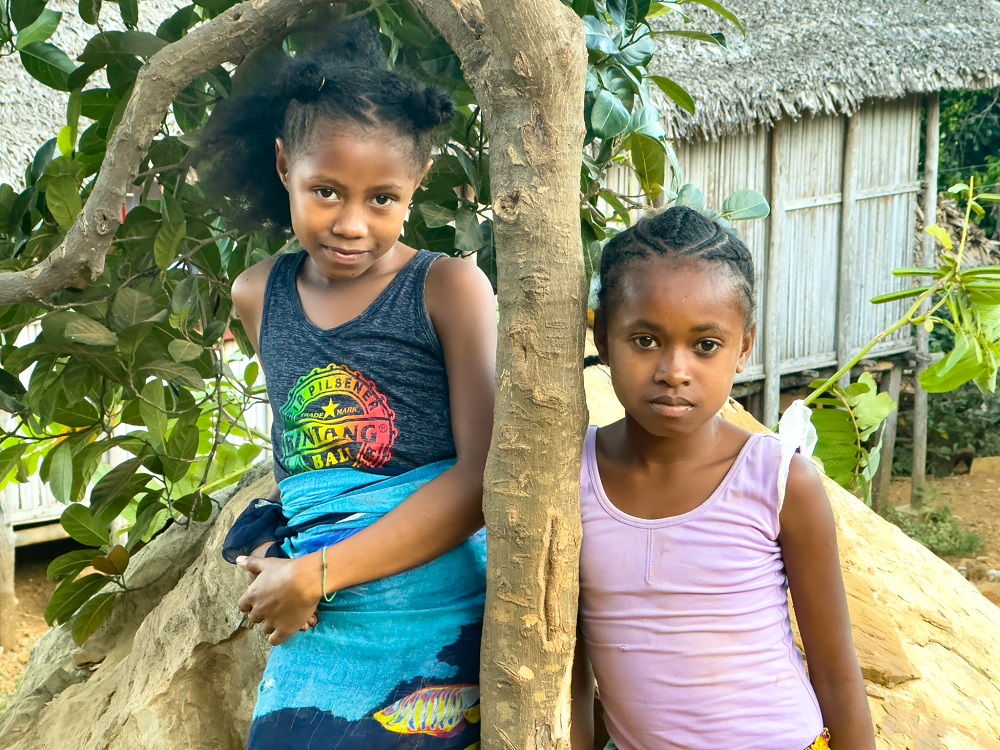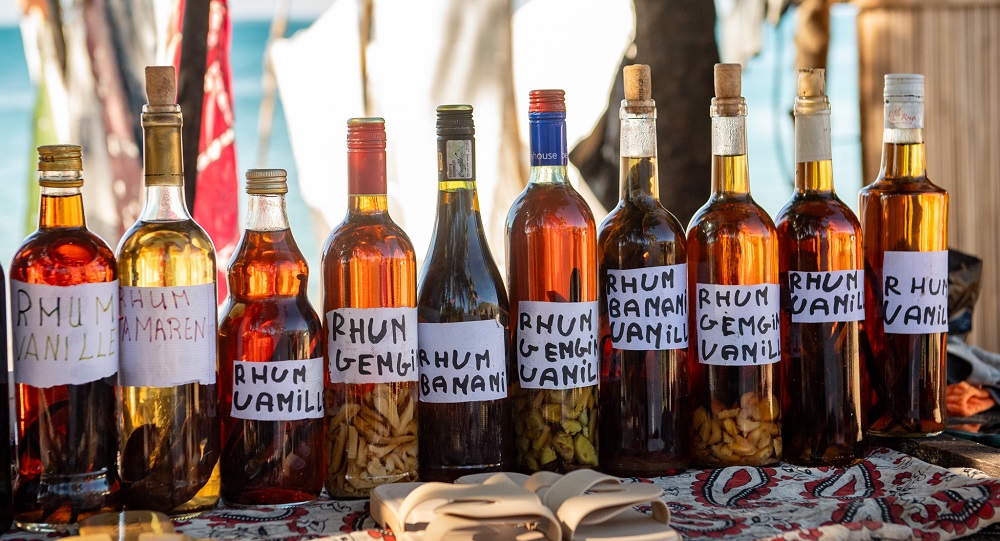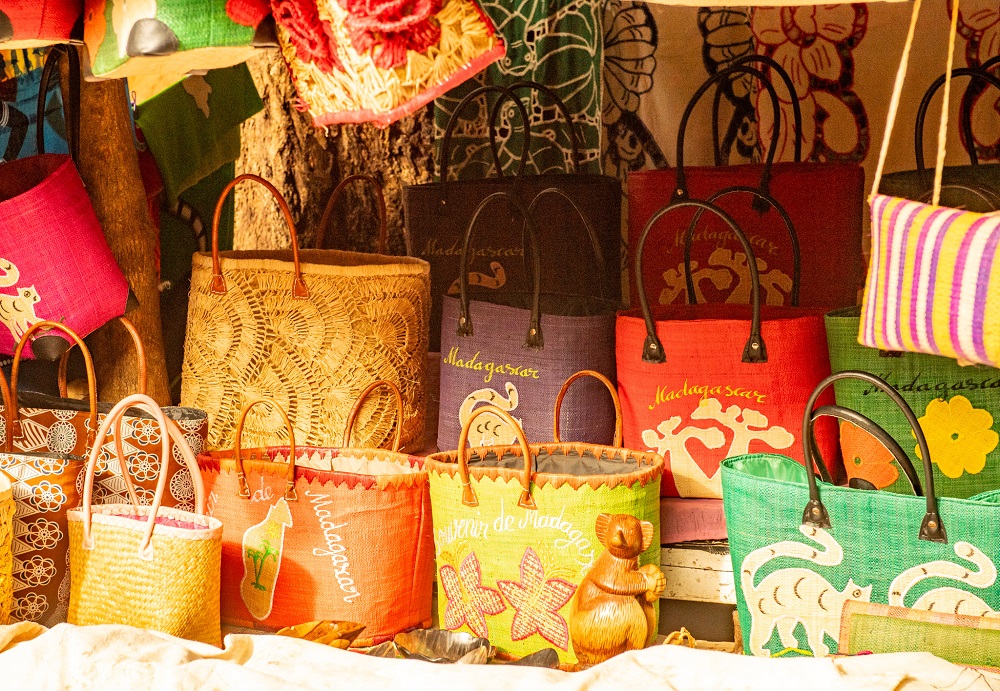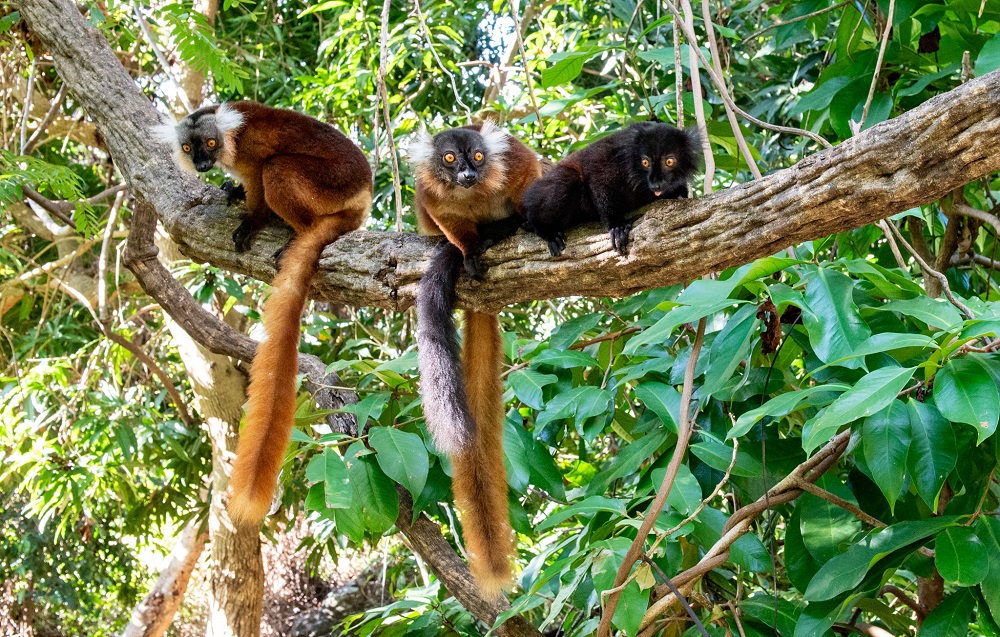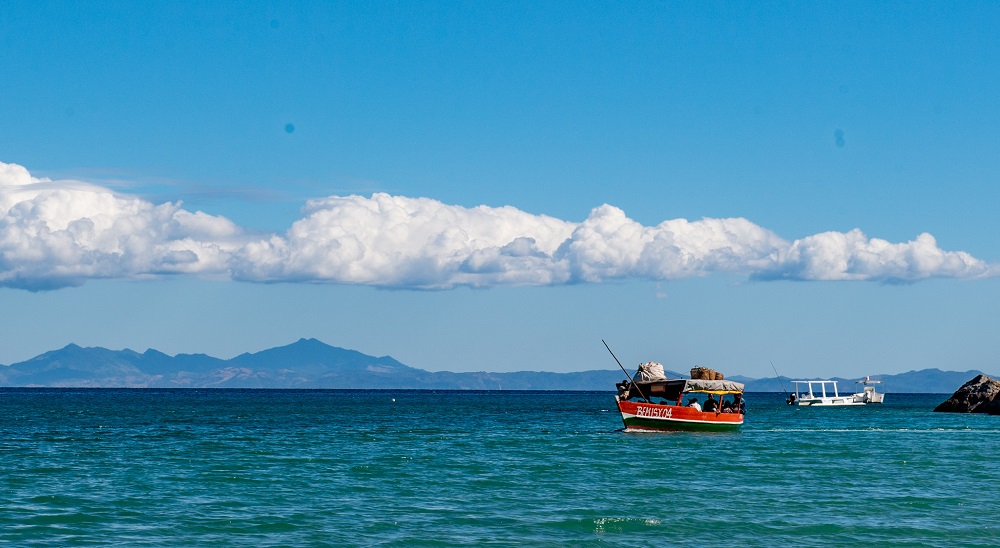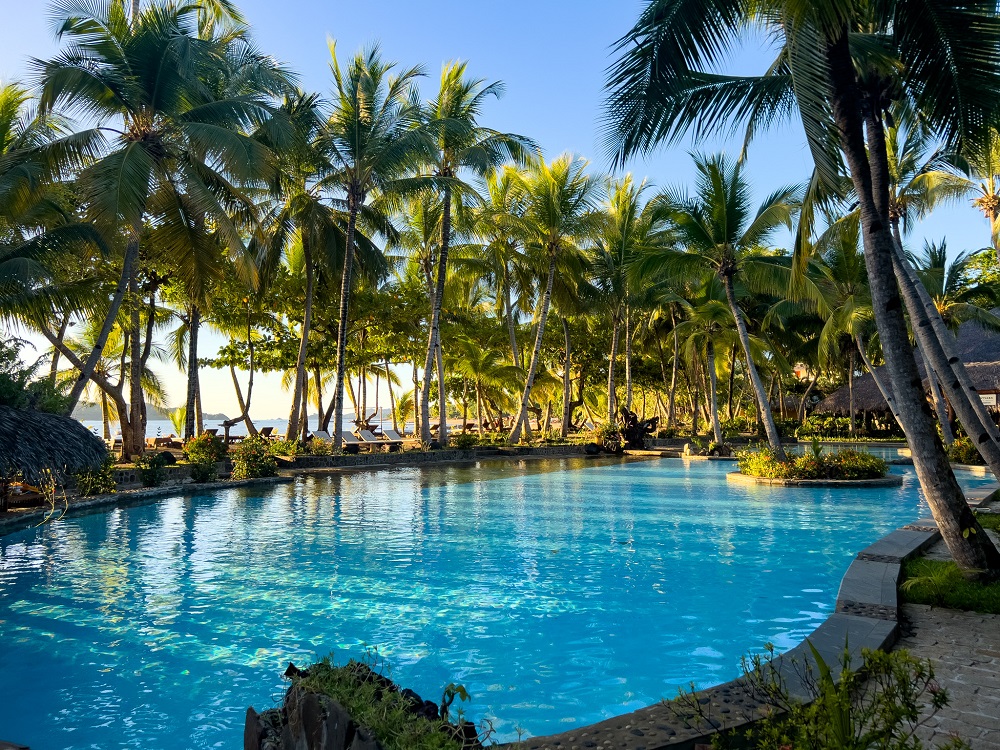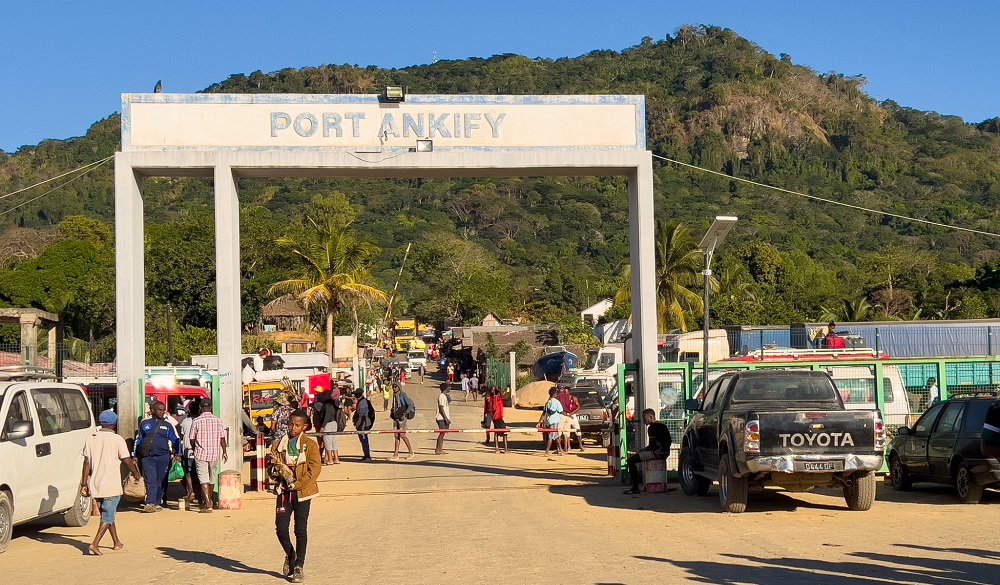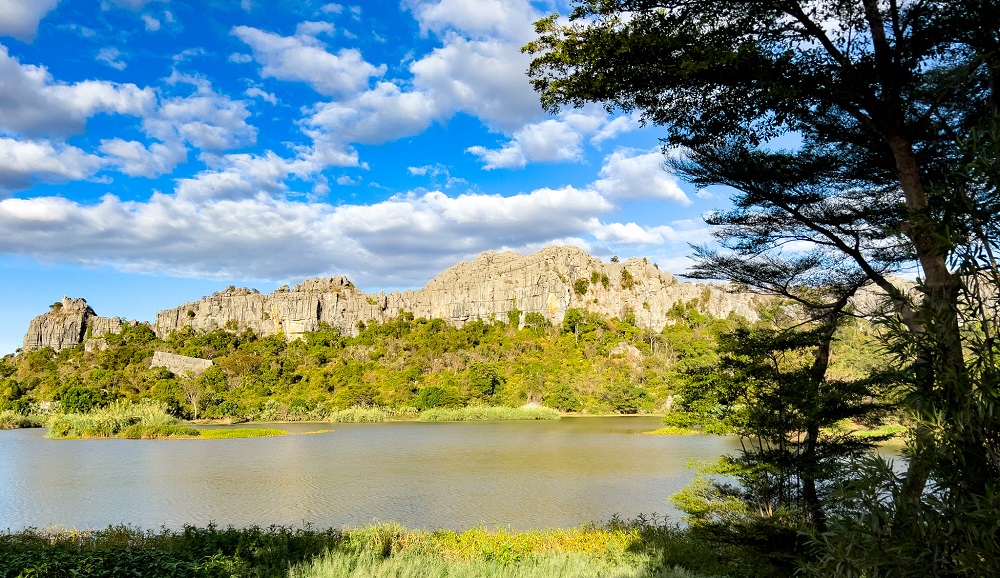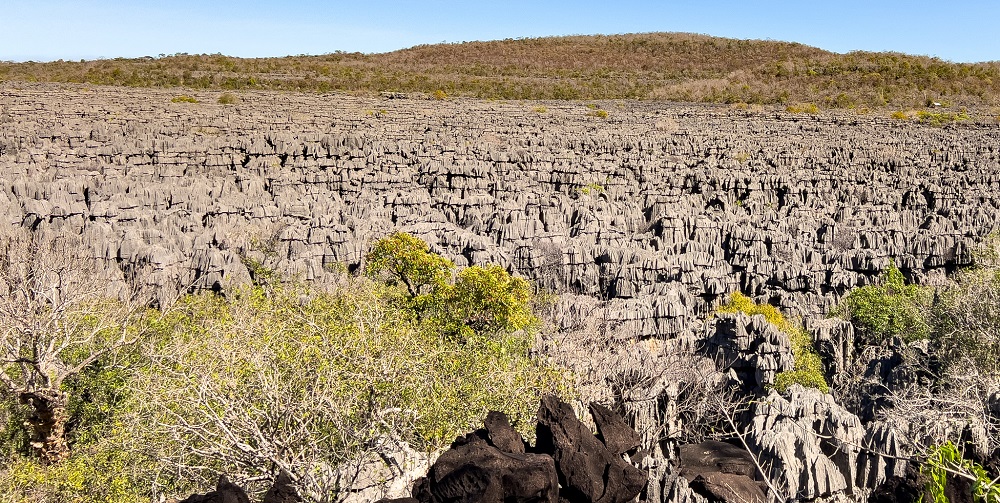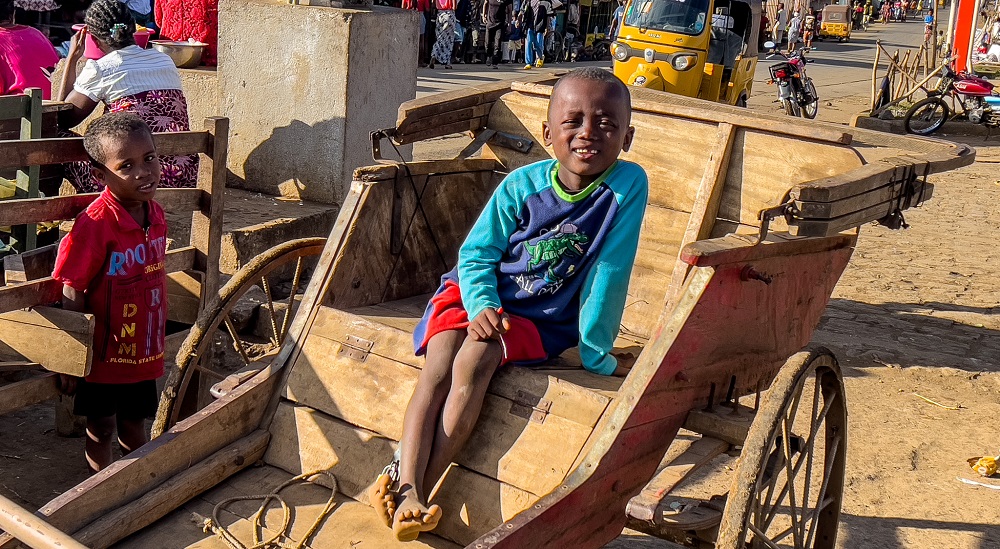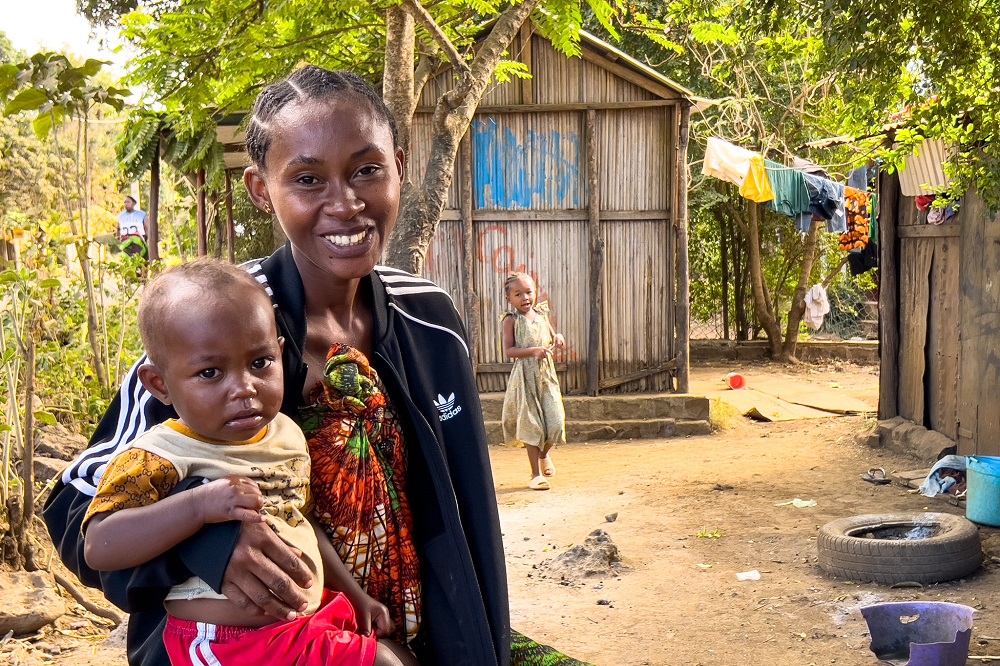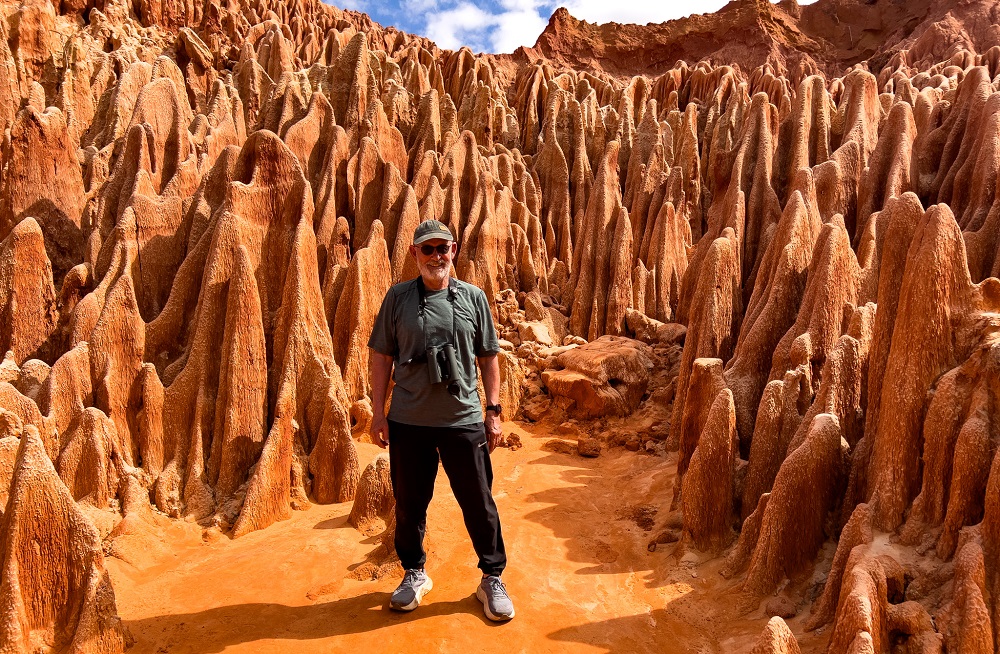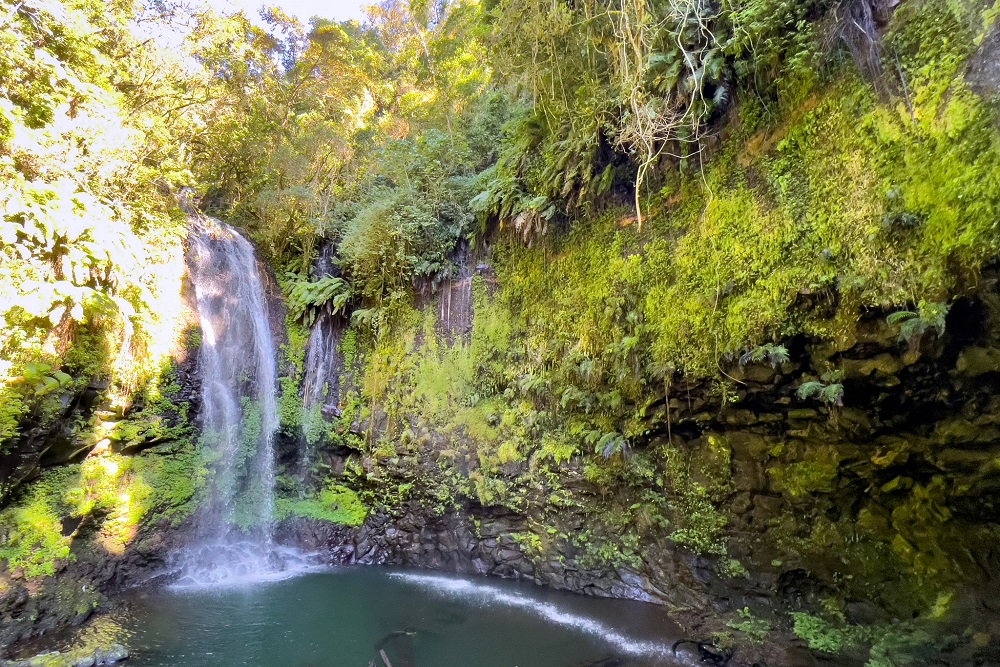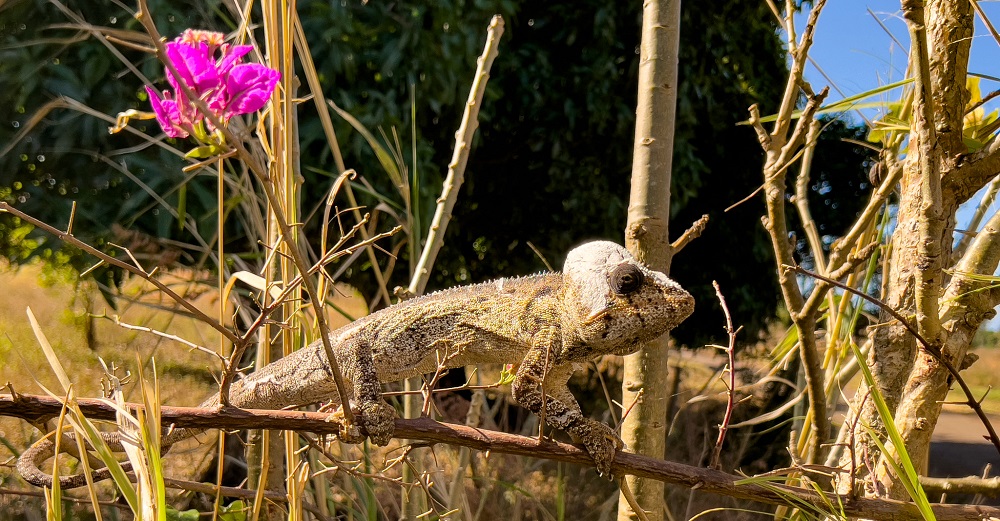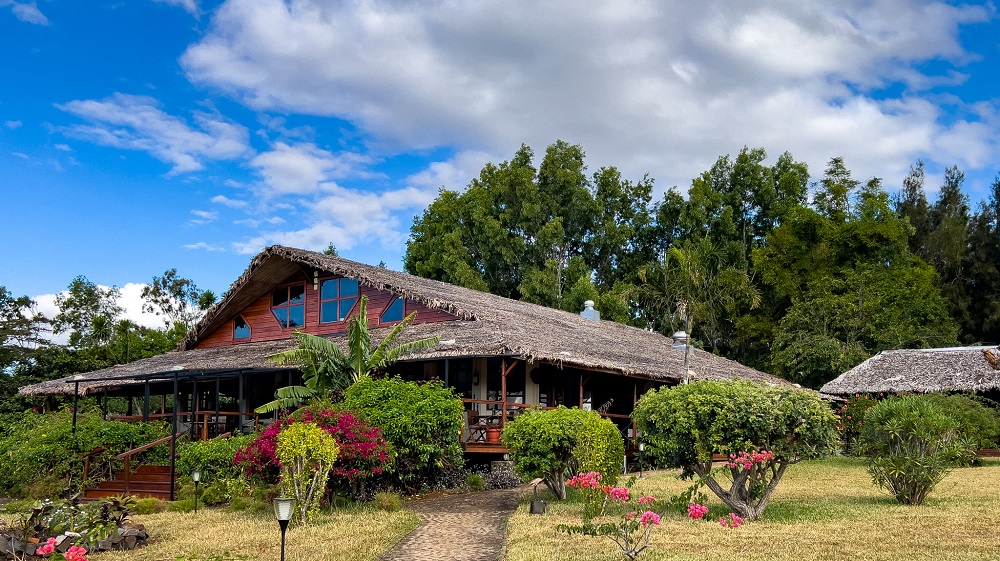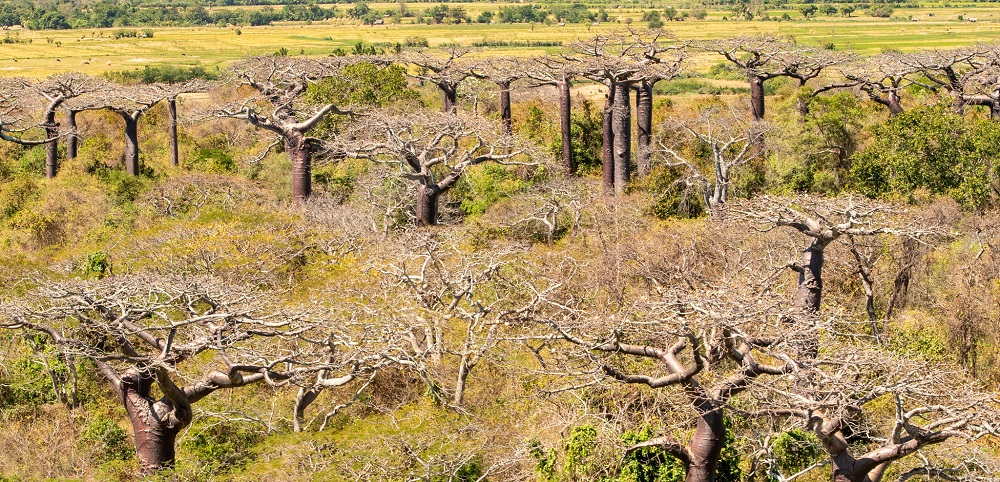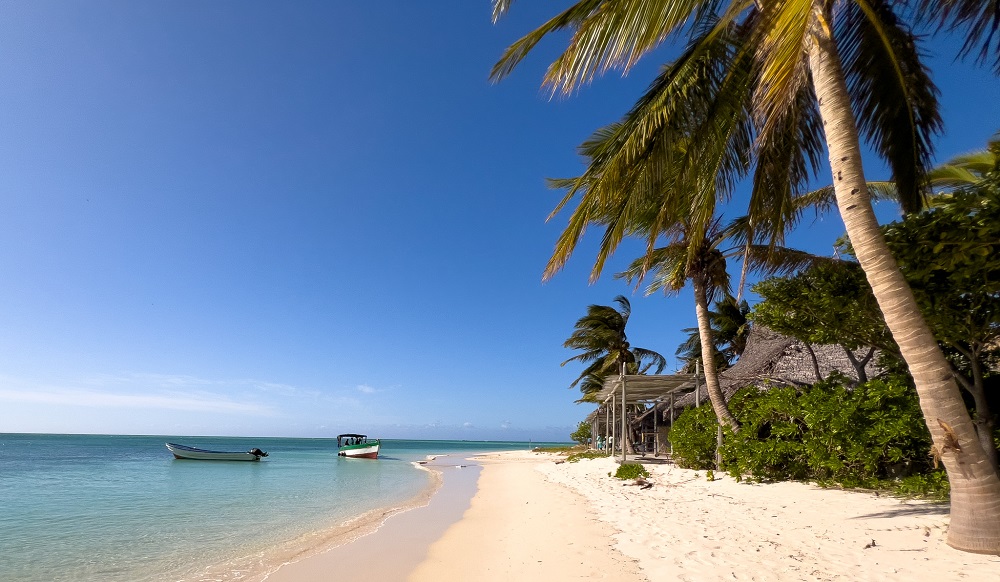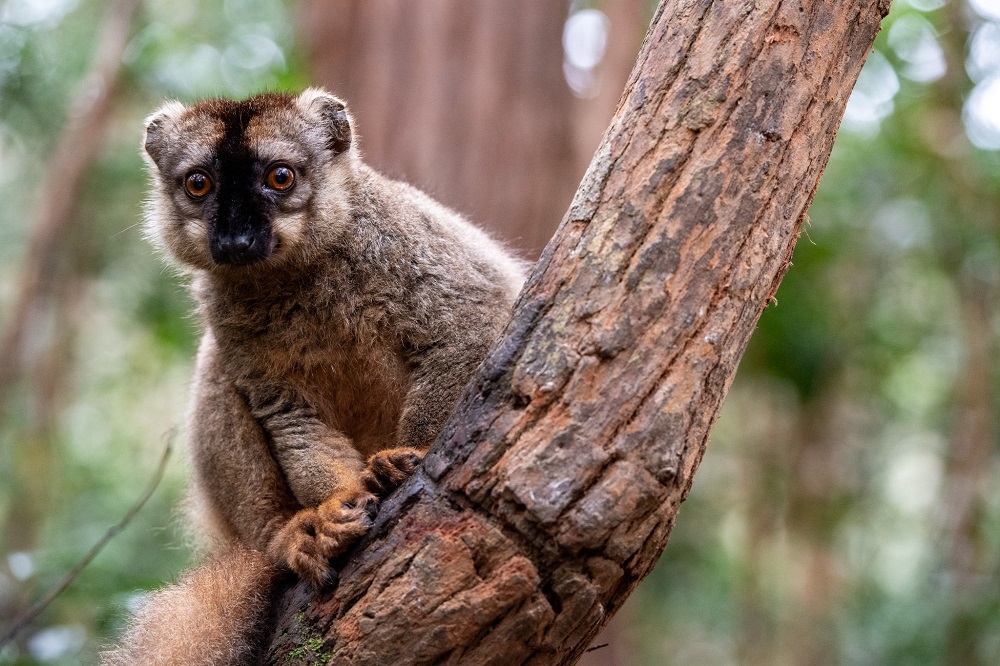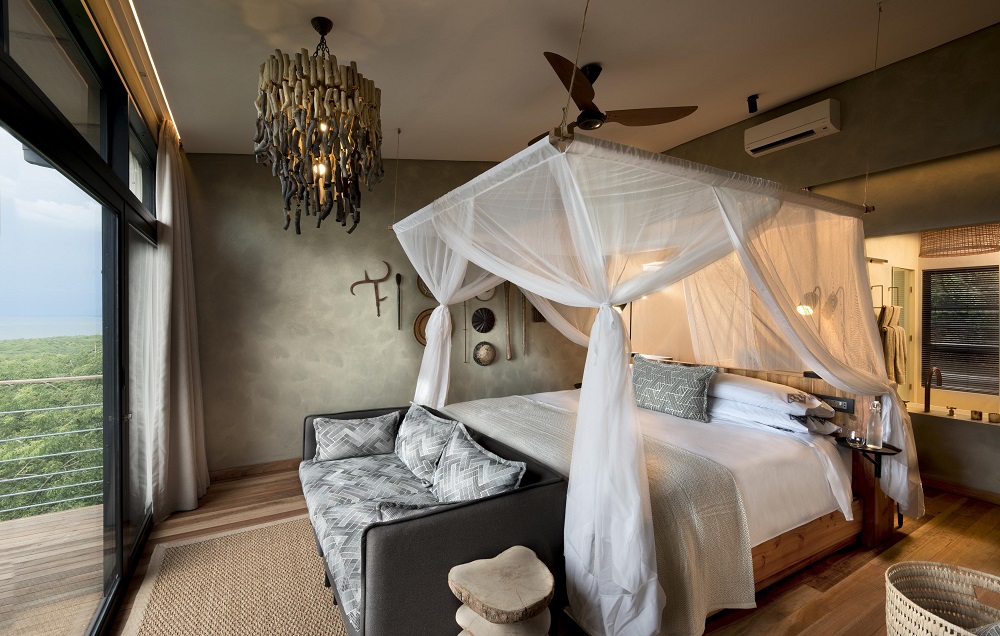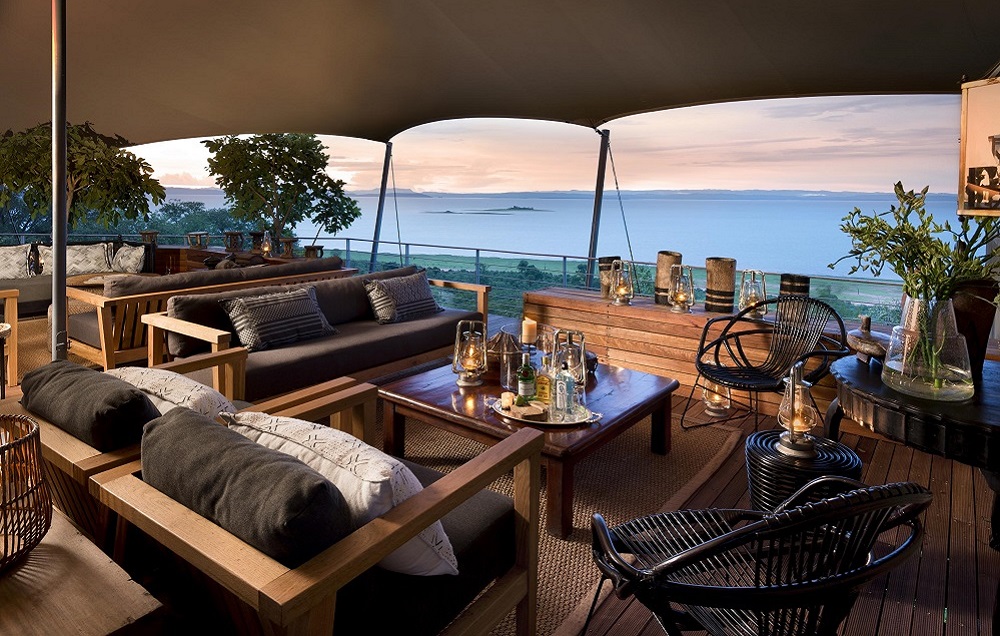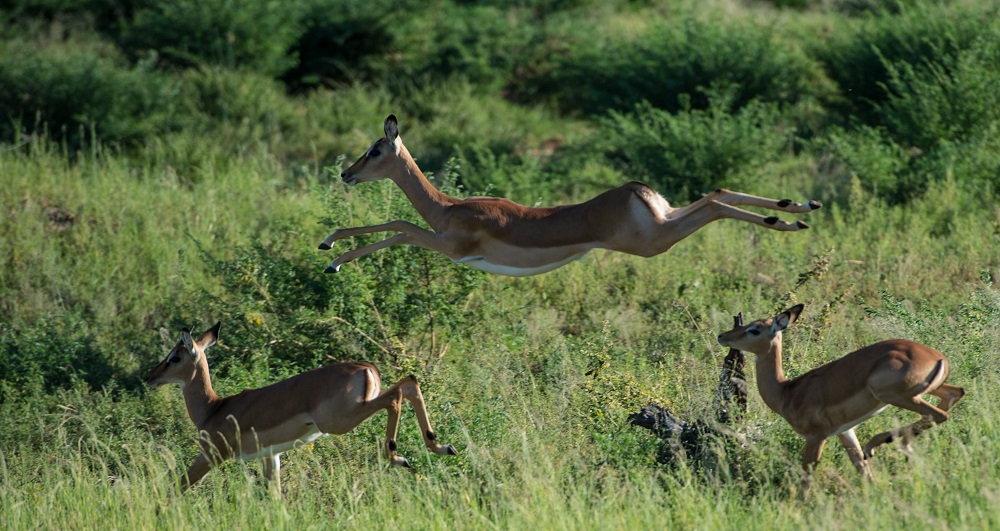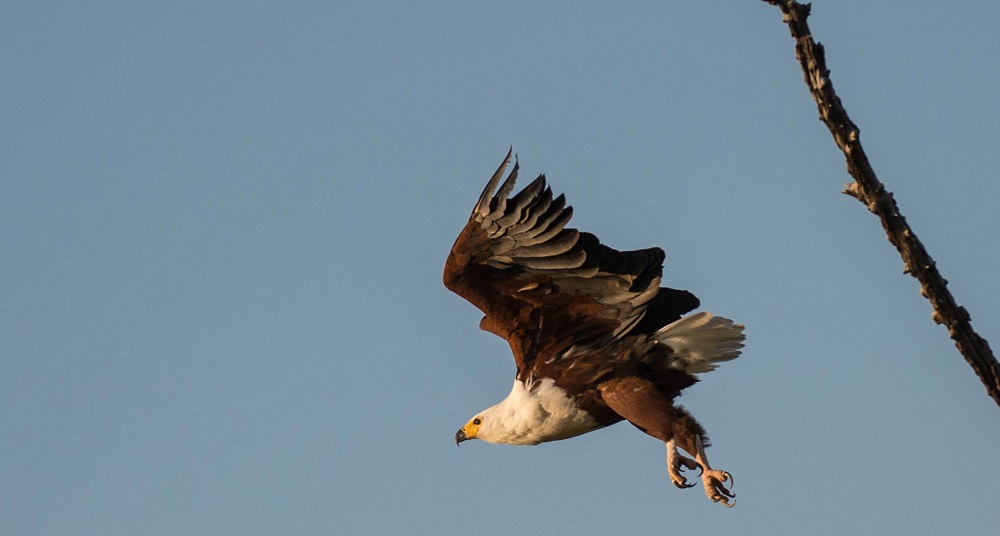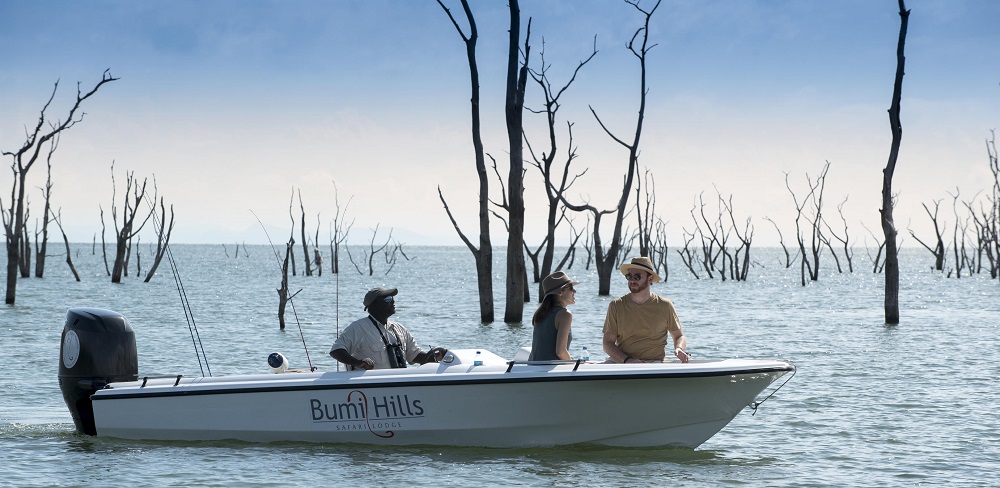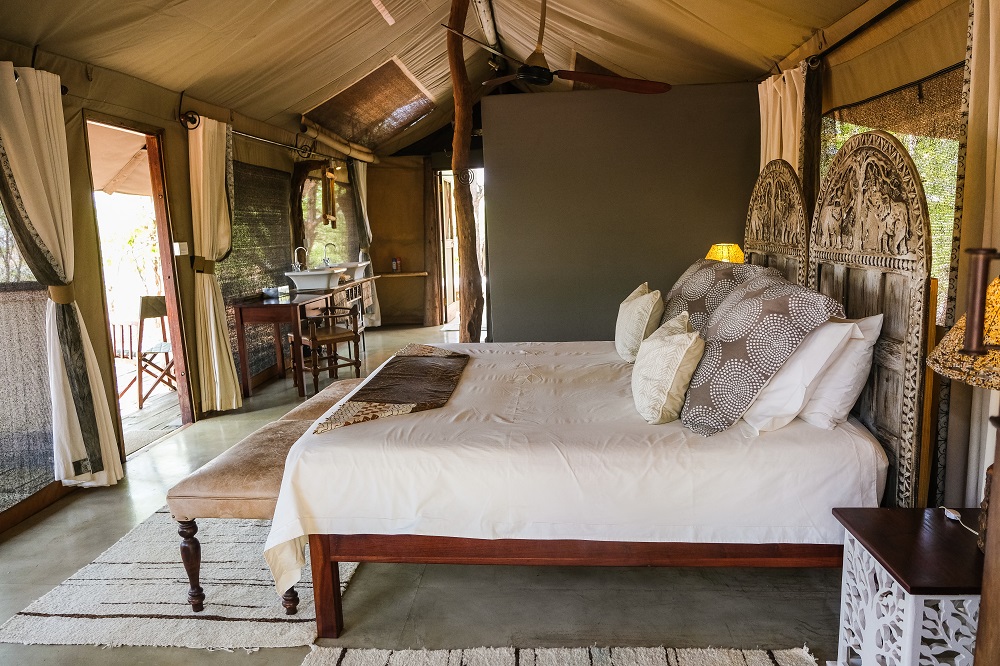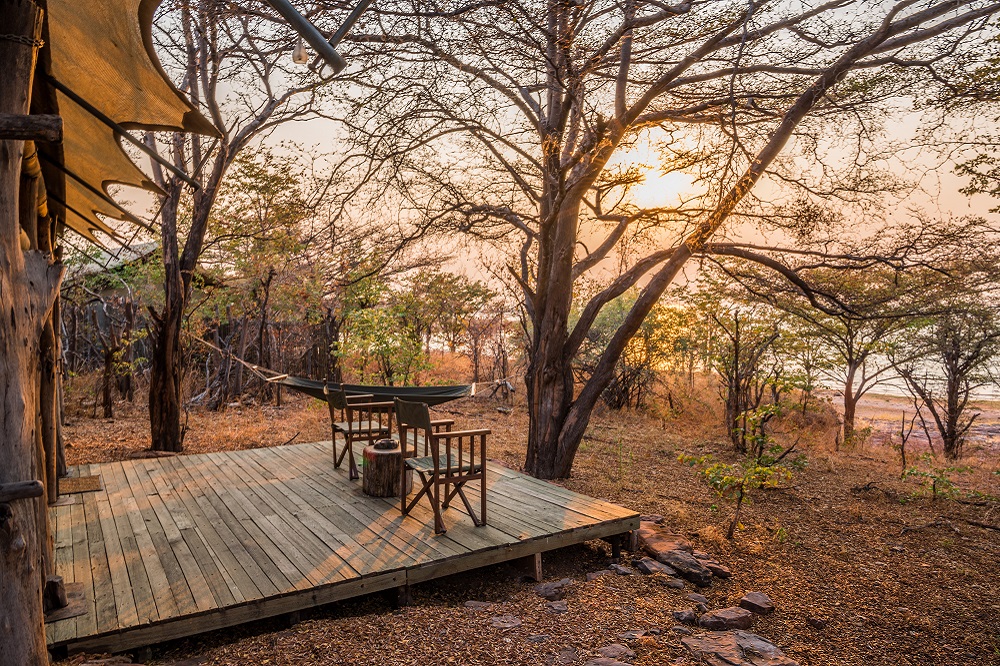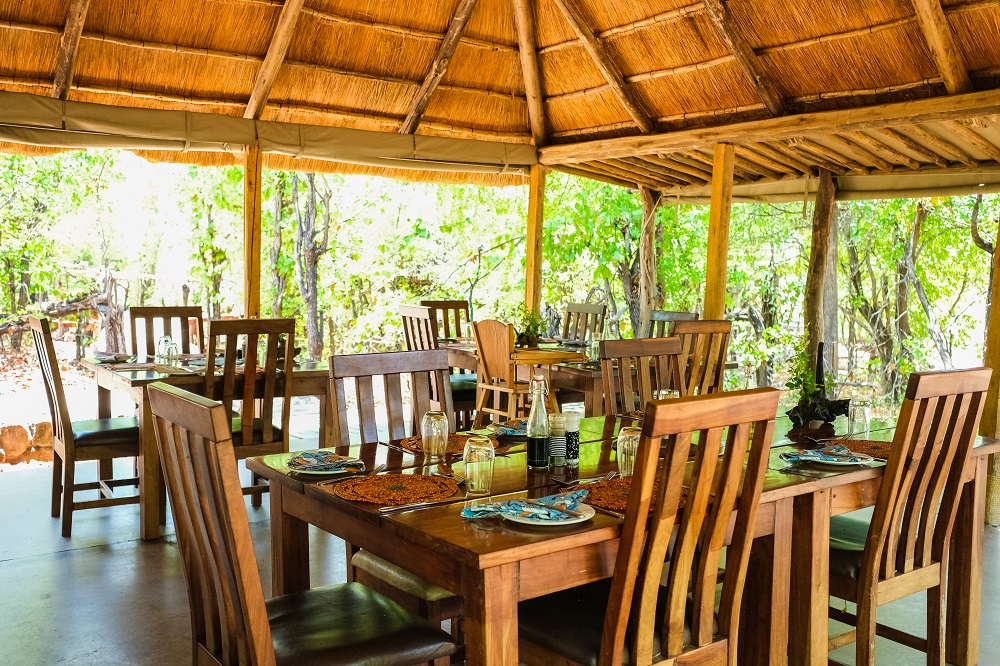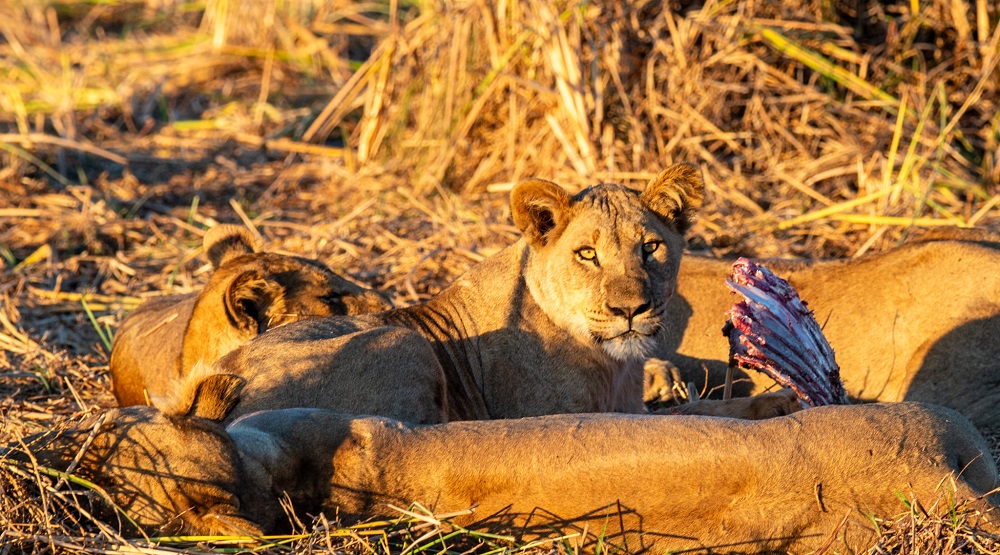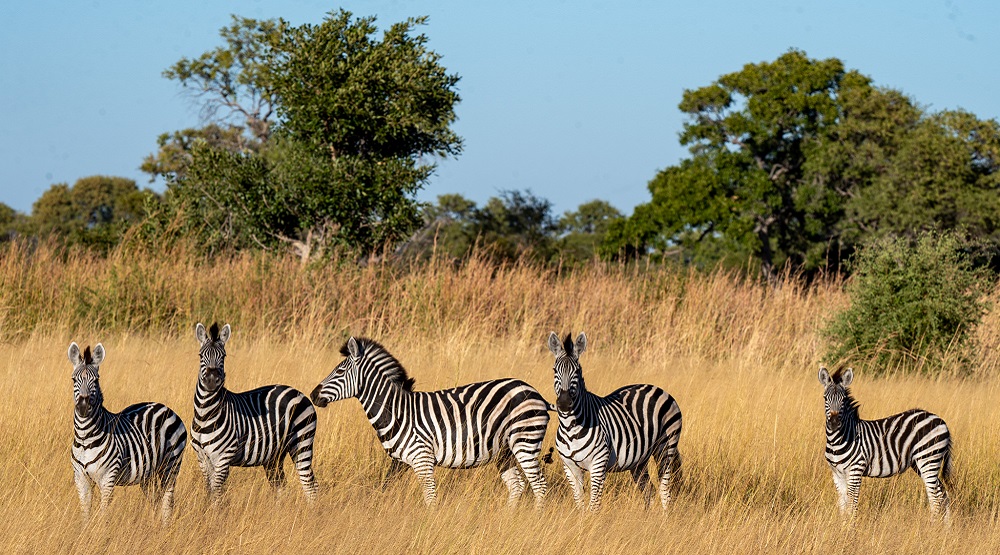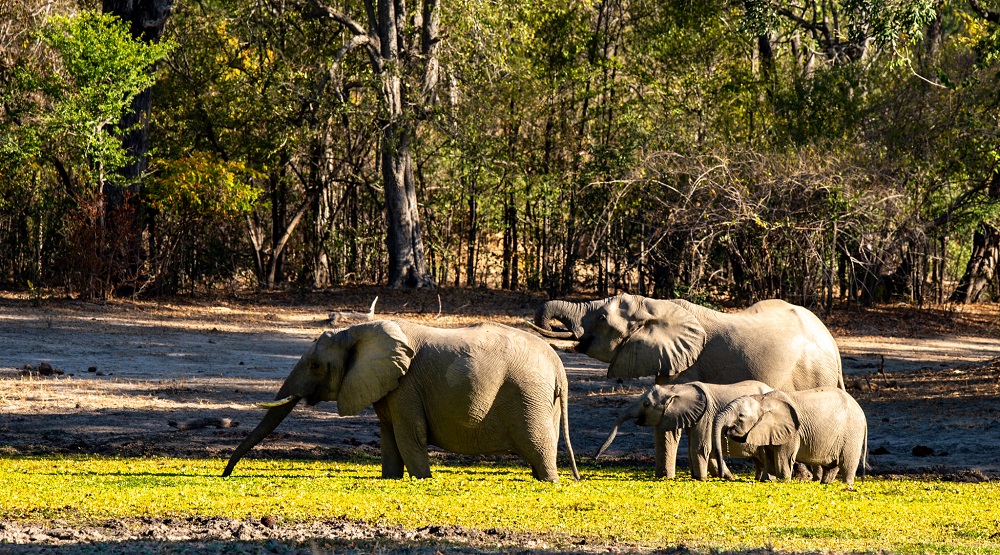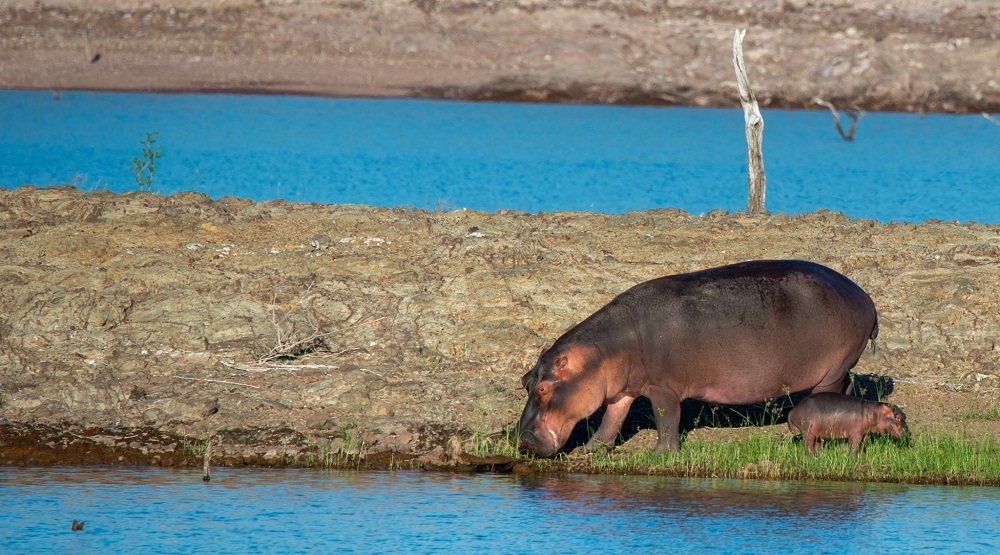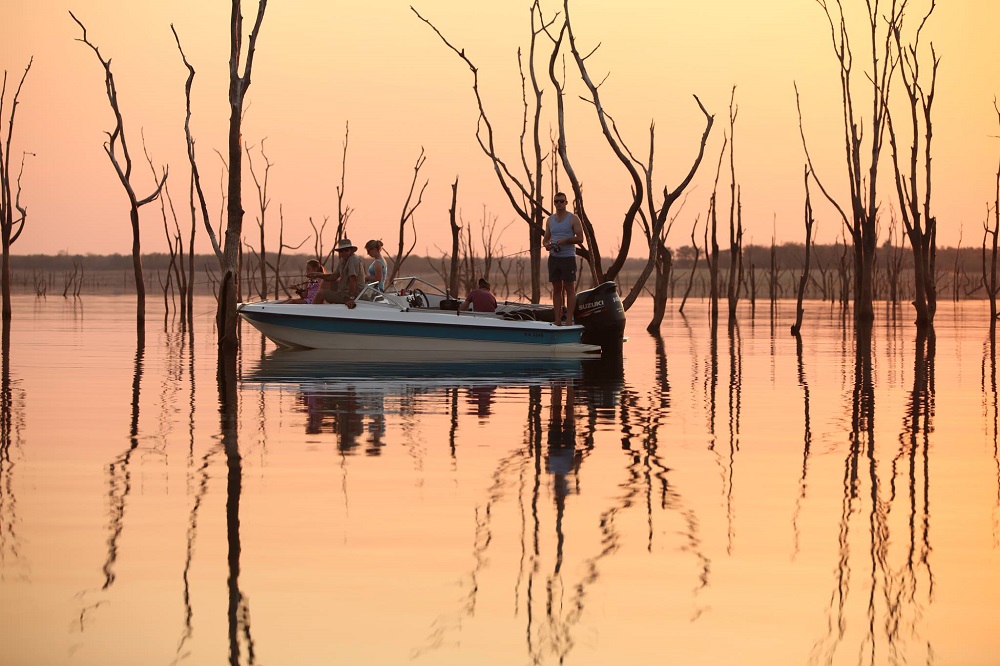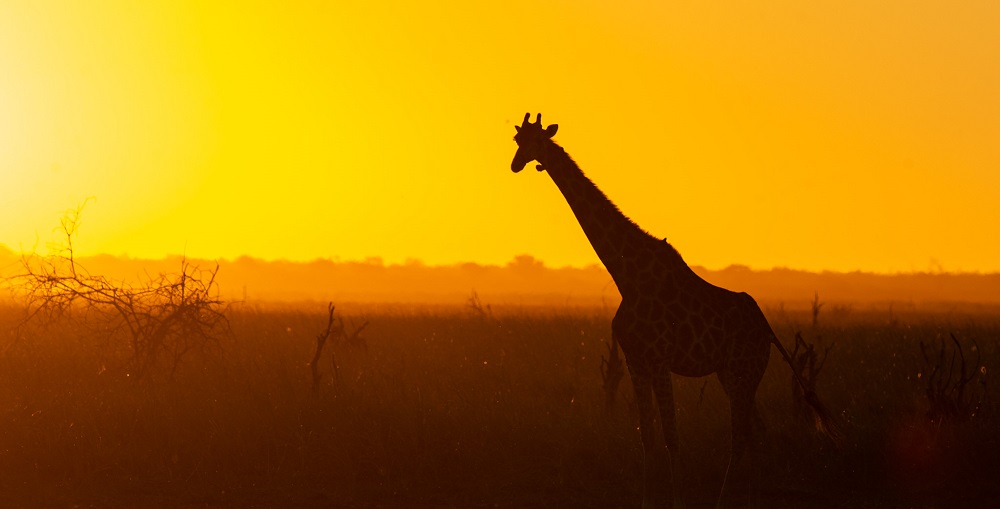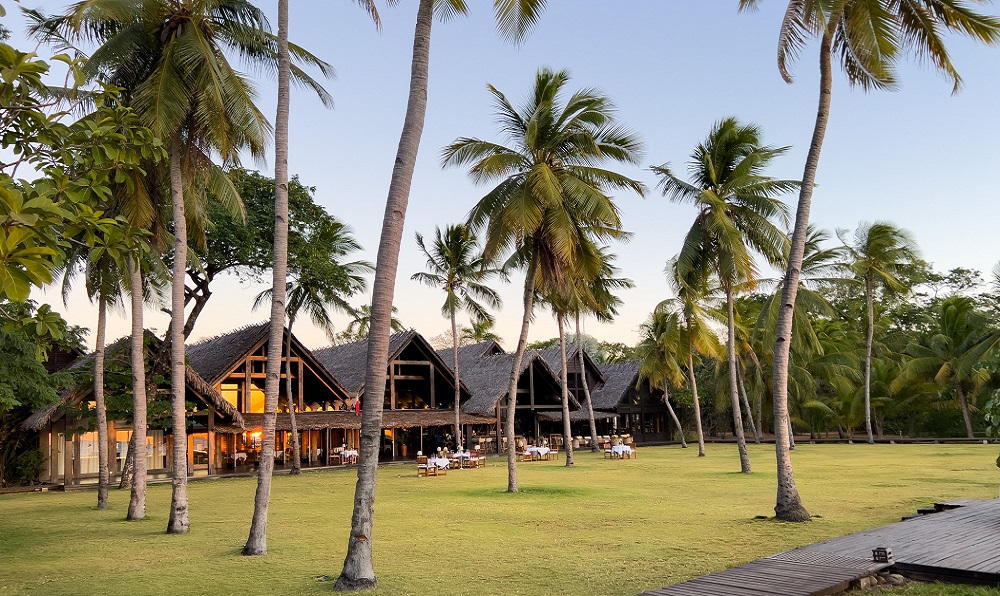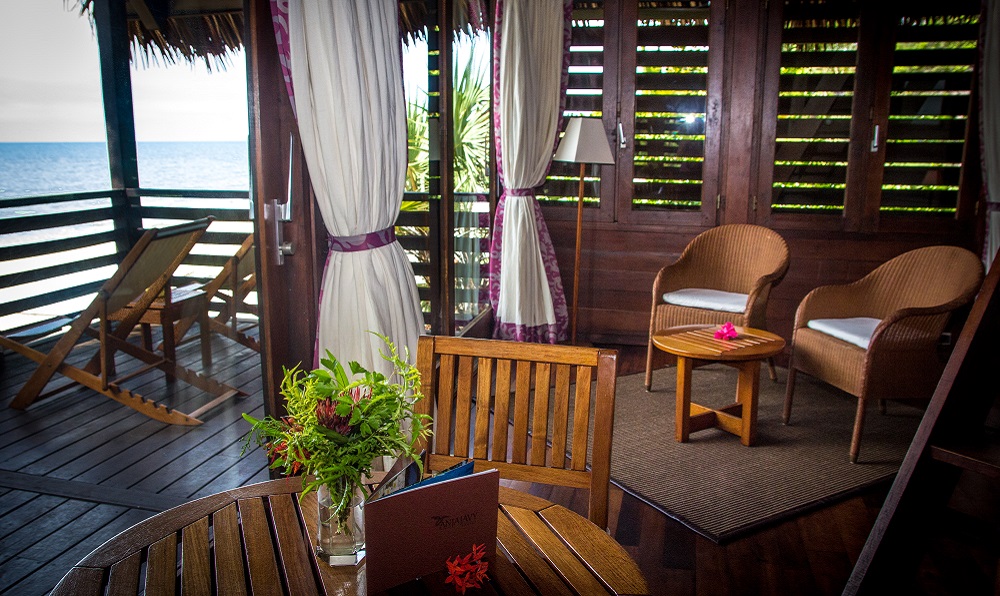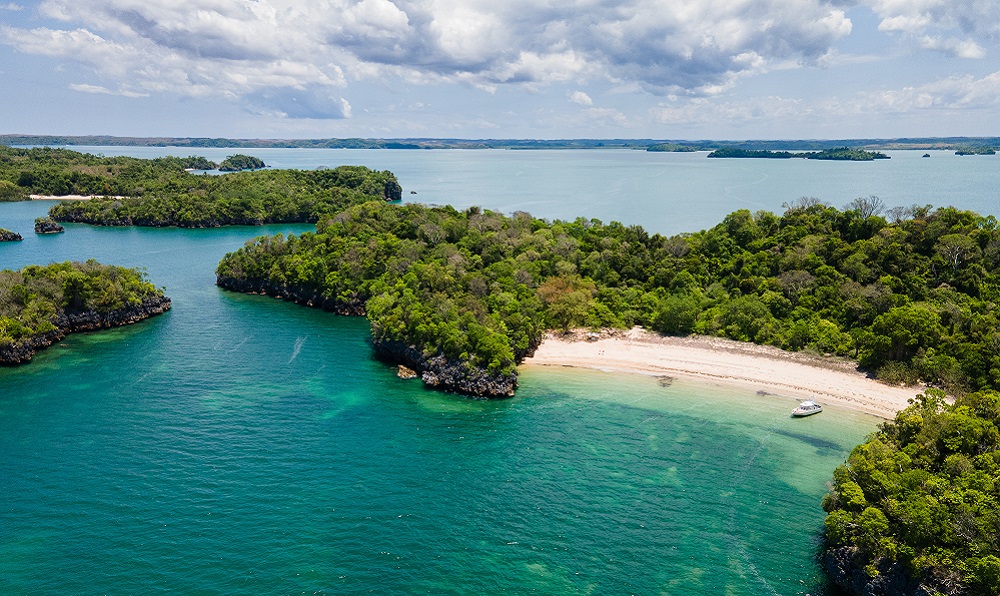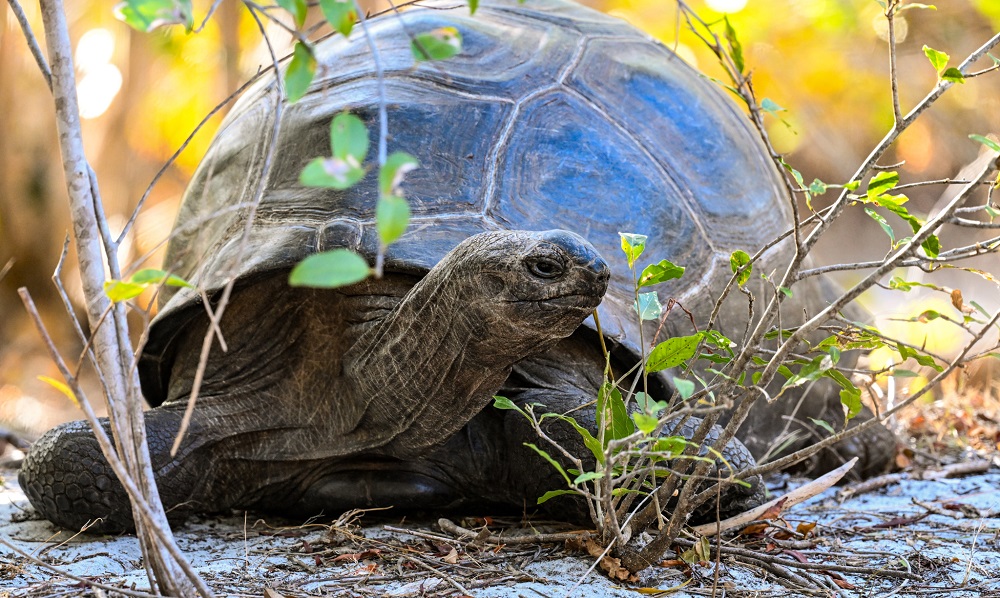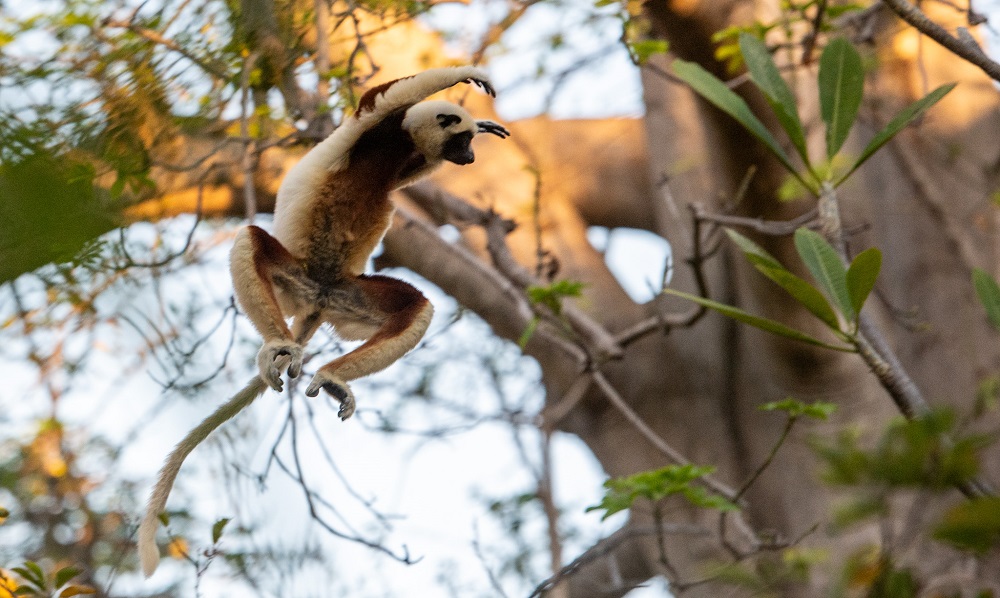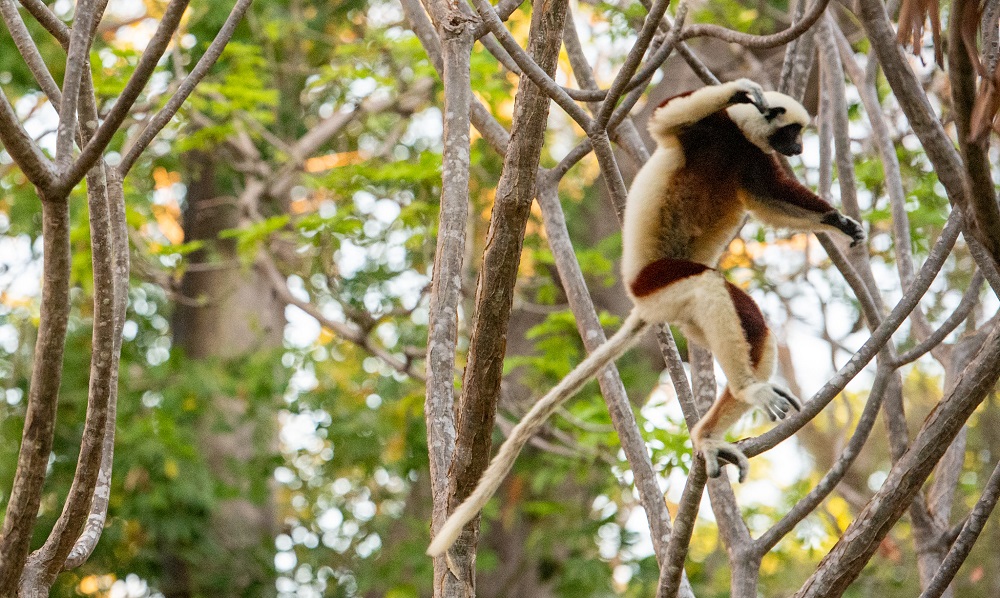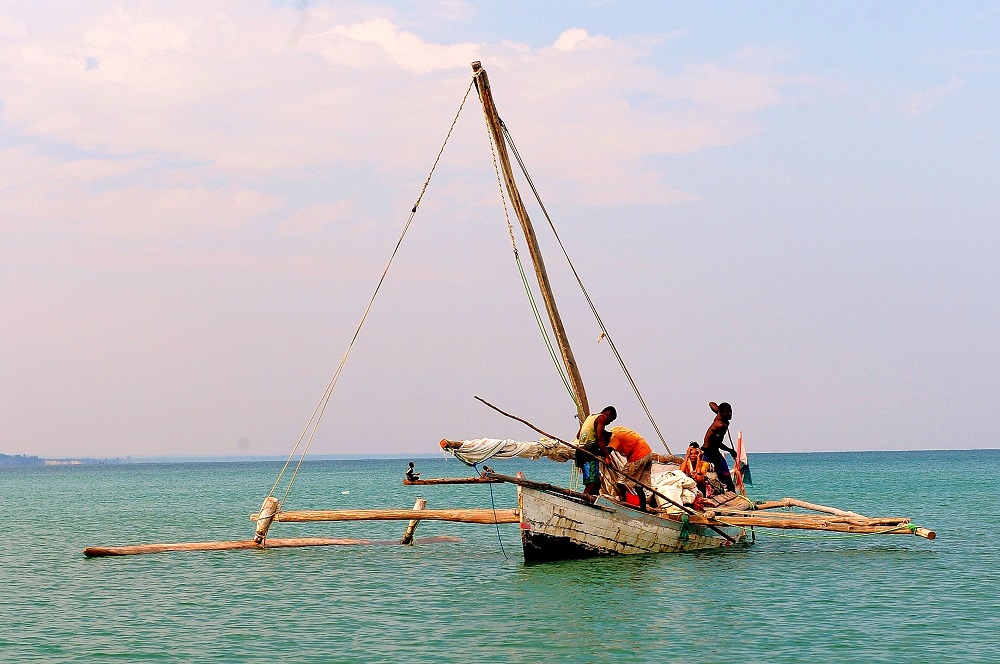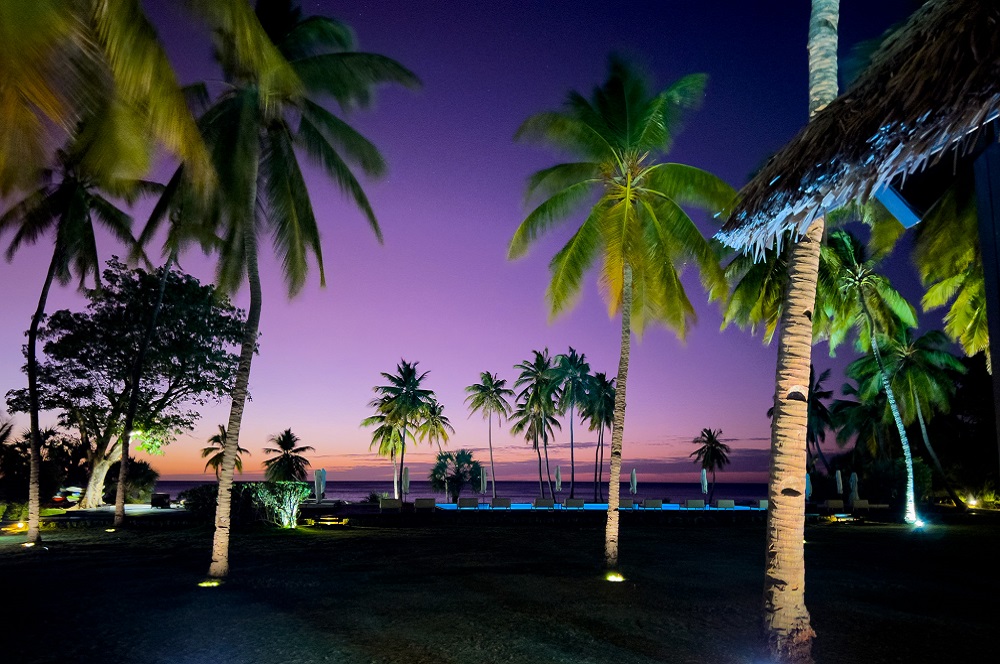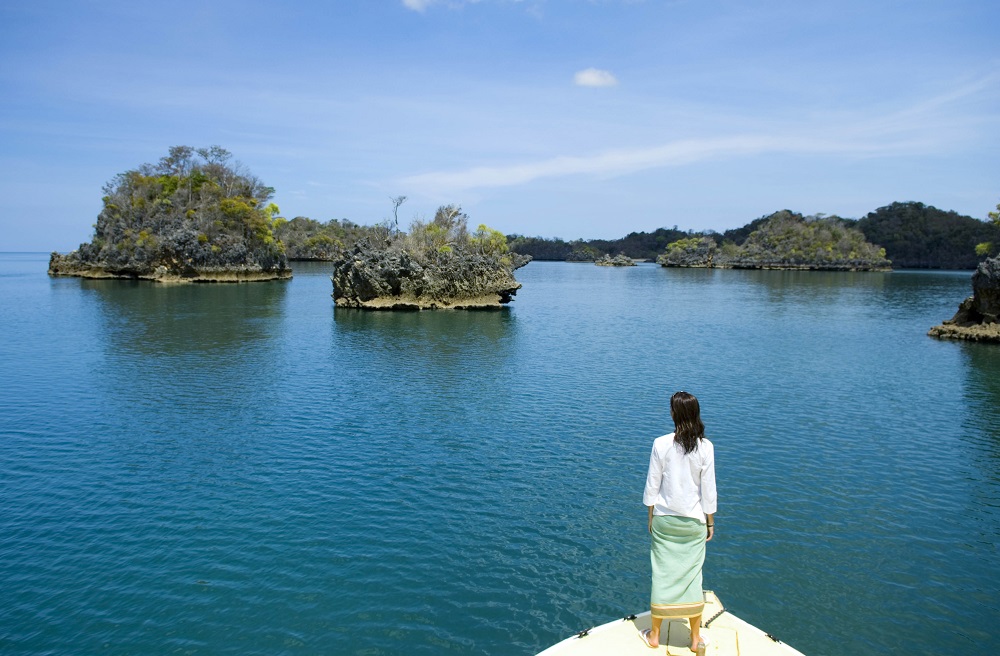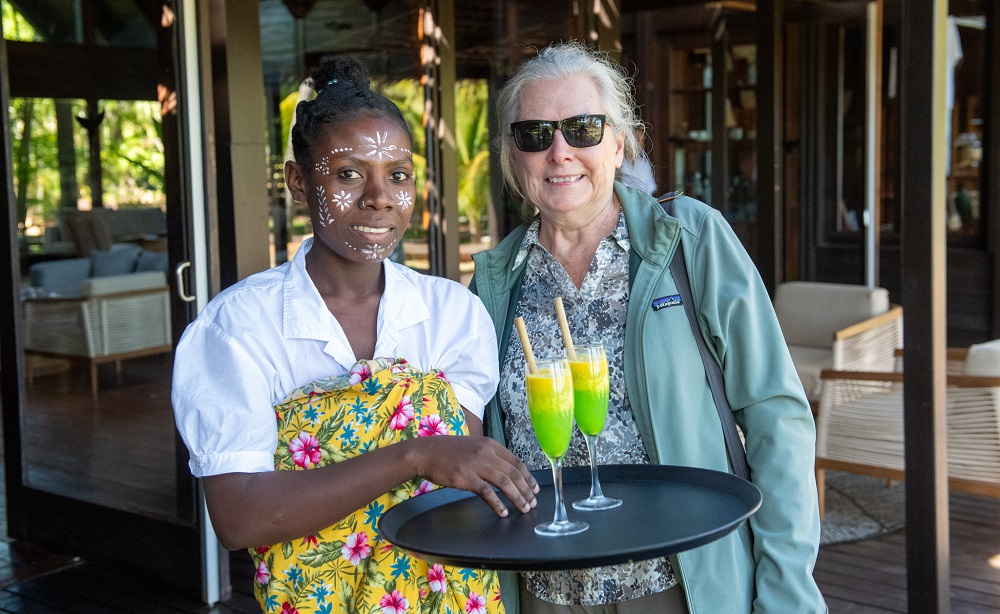Lyndon Revisits Mana Pools, Zimbabwe
Mana Pools is a near-legendary national park which lies along the lower Zambezi River in far northeastern Zimbabwe. Renowned for its game viewing (elephants, big cats, buffalo, plains game & African painted dog), the area is highly atmospheric and for many seasoned safari goers, Mana Pools is the holy grail. Being on the Zambezi and with the Zambian escarpment visible in the background across the river, the setting is very special too. Over the years, all of our team members have traveled to Mana Pools, checking out several of the properties in the area including Ruckomechi and Little Ruckomechi, Chikwenya (in its former and current iteration), John’s Camp, Vundu, Kanga and Nyamatusi. On his recent May trip with Christine, Lyndon visited two relatively new properties in Mana Pools, namely Mana River Camp and Ingwe Pan Camp. He also revisited Ruckomechi.
Ruckomechi Camp
We had an afternoon light air flight from Matusadona to Mana Pools and a short game drive on arrival. The flight was short, about 30 minutes, and scenic. The Kariba Dam was clearly visible from the air. Looking at it from 6,000 feet I couldn’t help but wonder how it has managed to keep all of that water at bay since 1959. Quite an engineering marvel. Our game drive was productive and after going multiple game drives without a cat sighting we spotted two lions not 10 minutes from the airstrip. It was a mating pair, a young male and female. They were exhausted and after observing them for a few minutes we let them be.
Just a bit later we found the brother of the male lion we had just seen. And he put on an absolute show giving us a roaring exhibition for the ages! If lions could be opera singers this guy was one of The Three Tenors. We heard him and his brothers roaring all night from the camp. Our sundowner was late due to our start time and our guide Faidon prepared it for us while we sat in the vehicle after the sun had already gone down. As he was preparing the drinks and snacks some elephants ran by us in a hurry responding to a call from one of their babies. Faidon is an impressive person having spent 42 years with African Parks before deciding to become a guide. 42 years! And he is so enthusiastic about wildlife.
Our activity ended with some spotlighting and we were very fortunate to see several genet cats and a serval, only the second one spotted by the camp so far this year. On our way back to camp we spotted the business end of a porcupine and also had to turn around and take a different route because the mating pair of lions had decided to take a nap in the middle of the road. Best not to disturb them…
Ruckomechi is perched very scenically on the river with the Zambezi escarpment in the background and surrounded by several very tall and shady trees. Hippos can be heard at night. During our dinner we had a couple of elephants walk right past the front of the camp. They tend to move around the area often, so escorts to and back from guest tents are mandatory when the sun is not up. Dinner was roasted chicken and garlic with rice and veggies served with rice. The soup was a tasty mixture of tomato, celery, and apple and dessert was a ginger tart. Everything was good.
As I discussed with my wife, the rooms are right out of goldilocks and the three bears. Just right. Just the right size, just the right amount of decoration and luxury, not too much and not too little. Everything that you need and maybe only a few things you don’t as well. It had been a very good start in Mana Pools.
The following day we did a couple more game drives and while they were not quite as productive as our initial one, they still delivered. Of course, we saw all the general plains game and a good amount of elephants and additionally we saw the lions a few more times. We were able to observe a small herd of eland and later a lone gigantic eland bull at a very close range, a rarity as they are usually shy and will run from vehicles. We briefly spotted the elusive honey badger as it ran across the road on its way somewhere in a hurry. During the afternoon we had a family of elephants walk through camp right by the tents, including ours.
*Camp photos courtesy Wilderness Ruckomechi
Mana River Camp
After our two nights at Ruckomechi we were scheduled to take a boat transfer down river to Mana River Camp. Pick up was 7 in the morning so we had a normal wake up routine and headed out to the beautiful main area to take in the views and enjoy some breakfast while we waited. After a short time we heard a boat engine and got ready to take the short drive to the ‘dock’ area. But then the sound disappeared, and we were left waiting for another half hour to 45 minutes. Eventually we saw a boat drifting downriver, powerless. The captain was actually rowing. Our transfer boat had broken down. Ruckomechi quickly reacted and sent a boat of their own to tow in the vessel and we were told another boat would come but it would not arrive for another 45 minutes. No big deal and our guide decided we had time to go for a quick game drive. Good thing we did because we managed to spot a couple big male lions! This kind of quick thinking is one of the reasons we love Africa. Things might go wrong but the people are resourceful and we can sleep better knowing that we and our clients are in good hands.
Once our new boat arrived we were radioed and headed over from our game drive to the dock. This boat was a bit smaller and had no roof but I think it must have been a bit quicker too. We zigzagged a bit down the river, the captain sticking to the deeper water as best he could. Soft drinks and bottled water were provided for us. It was quite an enjoyable voyage although we were heading directly into the sun and were moving too quickly to confidently wear hats. So we definitely received a little sun. In all, the transfer probably took an hour. We were dropped off and met our new guide, Richard, who was waiting for us at the designated pick up spot. After a quick trip to the National Parks office we were off on a drive in search of some lions that had just been spotted with a fresh kill.
En route we had a fantastic up-close viewing of a woodland kingfisher, quite a colorful and handsome bird. Richard said he had never been this close and was excited about the picture he was able to take. You know it’s good stuff when the guide takes out their personal camera.
The setting in Mana Pools could be described as quintessential Africa. It looks just like you picture it. Or at least how I do. Tall trees sprinkled in amongst open spaces and short grass. Sandy dirt roads that wind up and down and across dried up streams where you are thankful that the guide has a land cruiser. Green leaves and long dead and dried up stumps. A picturesque floodplain with a mountain range on the other side. In a setting like this it can be fun to simply be a passenger and be driven along for a while at times. Animals are present but there are quiet stretches that remain enjoyable.
After driving for a while, we arrived at the scene where the lions had taken down what looked like a big eland. The lions were as full as I have ever seen, the males comically so. There is a hierarchy when feeding and the large males eat first and can really gorge themselves. One in particular looked like if he had laid down on a hill he would have rolled to the bottom. It was around noon and hot outside and they were all panting heavily. I think we have all been out for dinner and had some regrets about eating too much… We spent some time observing them before heading back to camp.
Mana River Camp is an adventure level camp so it is rustic but has all the basics that you need in the bush. Electricity, check; running water, check; comfortable bed, check; good food, check; and most importantly friendly and thoughtful service, and high-level guiding. Check and check. The location is pretty special too with the camp about 12-15 feet up overlooking a nearby island right on the Zambezi. There are plenty of large trees here to help shade the tents and keep the temperature bearable. All the rooms have a standing fan as well. There is WiFi but it has been inconsistent so I wouldn’t count on joining any Zoom meetings from here. Not that you will want to.
Activities here and in Mana Pools generally include game drives, walking, canoeing, and fishing. Often game drives will be mixed with walking as the guides love to drive for a while and then either go for a walk where they know there will be animals or when they see for example an elephant in the distance or something of interest. The walks can be very rewarding and a welcomed change of pace from sitting in the vehicle. You will be given instructions about following in a single file line, watch your step, listen to the guide’s instructions at all times, and of course the golden rule of the bush – whatever happens, don’t run. The walking guides here are the best in the business. It takes a long time – as much as five to seven years – to become qualified. In fact you need to go on hundreds of walks with other pro guides before you can lead them. And before you do that you need to be fully certified and trained with a rifle which the lead guides carry with them on all walks.
Our evening game drive involved such an instance where we did a drive and got out of the vehicle multiple times. Once in order to get a closer and lower to the ground view of a bunch of vultures that were feeding on the remains of a dead hippo. We followed the guide and listened when he said to duck a bit here and there to try not to disturb the birds. Later we drove to one of the four actual Mana Pools for which the park received its name. In the distance a large male elephant was walking towards us. We got out and our guide expertly positioned us to see the elephant cross us and enter the water. And with the sun behind us as well. Hopefully I got a couple good photographs. Richard is very attuned with the needs of photographers and even though I would still consider myself a novice in this regard I am confident even seasoned photographers would be in good hands.
The following day we had a walk for the ages. In the morning we headed out to find the team members who monitor access to the painted dog den sites to prevent too much stress on the animals. When we caught up with them they were in their vehicle tracking the collared members of the pack. It was apparent the dogs were on the hunt and we followed the vehicle for some time before managing to spot one of them briefly at a bit of a distance. Afterwards we went for a walk of about an hour and a half during which we saw elephants, buffaloes, and finally four lions! I had never seen lions while on foot so that was quite the thrill. It can be very rewarding to see so many animals in that kind of setting. Even while on the vehicle we noticed that there are not too many other vehicles driving around. You do see the occasional car from another camp or even a self drive group but for the most part it feels very remote.
The season in Mana Pools generally begins at the start of May so at the time of our visit it was still early in the dry season. It will be slowly cooling down through June and July and much of the wildlife will be flocking to the floodplains as food and water run out further away from the river. This year is expected to be rough as there has been quite a severe drought. Conditions in May were already more like they are in June and July in most years due to the impending drought. It should be a dramatic scene as we move on through the dry season.
For our evening activity we chose to fish. Canoeing is a popular activity here and in Mana Pools in general as well. With the water level in the river being so low I didn’t think it would be as enjoyable. The fishing activity took place essentially in camp just at the other side and towards the back. We fished from a raised bank directly into the Zambezi about 12 feet below. We almost instantly received bites and before long we had both our first catch, mine a tiger fish and Christine a large catfish. Before it was all over I also managed to snag a large catfish. The activity was a blast and I would definitely recommend trying to mix in a fishing activity during your time here. It can be a relaxing way to enjoy the area in between game drives and walks.
Editor’s note: the camp actually kept the tiger and Christine’s catfish. We assume they ate the catfish and prepared the tiger for us. My goodness was that thing bony. That is what everyone says about them and I can now fully confirm. The camp manager, Shepherd, said that the usual preparation involves boiling it and letting the bones separate. Then they take the meat and fry them into meatballs. This way they don’t have to deal with all the bones.
Ingwe Pan Camp
The next morning we did a transfer/game drive to Ingwe Pan. Nothing too notable as far as animals en route but you can definitely tell the difference between the camps near the river and on the floodplain, such as Ingwe. As one moves further away from the river the forest becomes quite a bit thicker and the bushes cover up most of the gaps that you would typically find by the water. It is not usually until the end of June and July that a lot of the leaves on this vegetation will fall off making it much easier to spot animals.
Ingwe Pan camp is located in front of a pan with a constant supply of water so once all the other pans in the area dry up, it becomes the only source of water around. Even by mid May – with other sources of water still available – the pan was a productive location for game viewing. Elephants visited the water every day that we were there and actually walked directly in front of our tent on both days. Often you require a guide escort to get to your tent even during the middle of the day. Thrilling to witness the animals at such a close proximity! The main area has a really fantastic view of the entire pan and plenty of seats to take it all in. Meals are eaten here and the service staff is also super friendly so it is a nice area to spend some time in between activities. The rooms are spacious and well lit with indoor and outdoor showers and a fan above the bed for when it gets warm. I would rate them as quite comfortable, luxurious even.
*Images courtesy Ingwe Pan
Ingwe has a small concession but is unable to conduct night game drives with spotlights as of this writing. Our guide AB took us out for a game drive in the evening and we were able to see numerous elephants at the surrounding pans as well as a good amount of plains game. For our sundowner we went to a seasonal riverbed and enjoyed the view as well as the slightly cooler temperatures thanks to the sandy ground. AB is an excellent guide and made our experience with Ingwe two for two in that regard. He is very engaging and I could listen to him talk about wildlife for hours.
The meals at Ingwe were the best we had on safari this trip. There had been some really good meals but by the end of our stay there was no doubt.
After our first game drive the following drives were unfortunately a bit quiet but as I mentioned earlier, I believe the game viewing will pick up significantly as we get further into the winter. One of the highlights was actually seeing the drag marks that a leopard had made after killing something near one of the pans. There were hyena tracks following and we did not get to track them to the end but can only imagine what occurred. When we had to leave for the airstrip and head back to Victoria Falls we did catch a pretty good glance at a big male leopard who came out of the bush on one side before crossing the airstrip and heading into the bush on the other side. All about five minutes before our plane arrived. What a stroke of luck!
Lyndon is ready to answer any questions you may have about visiting the Mana Pools area of Zimbabwe, as well as Hwange, Matusadona National Park and Victoria Falls. He can be reached at lyndon@fisheaglesafaris.com or by calling our office any time (irrespective of your time zone) at 1-800-513-5222. One of us will call you back.
Madagascar Property of the Month: Tsara Komba
By breakfast on day two I was hooked on Time & Tide’s Tsara Komba, an intimate island resort with 8 ocean facing chalets on the beautiful small island of Nosy Komba, in far northwestern Madagascar. All it took was a taste of the most divine ‘pain au chocolat’ followed by a bite of a perfectly executed croissant. Only the French could invent something quite as decadent and delicious as pain au chocolat. However, it takes an exceptionally gifted and dedicated chef like Tina Hary at Tsara Komba to get it just right. Light and airy, perfectly flaky, not at all greasy and with just the right amount of texture and color. A work of art. Does the local chocolate tip it over the edge from breakfast food to sheer indulgence? Bien sur.
Much the same can be said for the overall experience at Tsara Komba. At the time of our visit in early July the place was firing on all cylinders under the energetic and seemingly tireless direction of Resort Manager Nava and her capable team.
The setting and view
No doubt, there are equally good and maybe even better views at beach resorts elsewhere in the world than at Tsara Komba. What makes this one so special? It’s a multilayered cake. There’s a pretty sandy beach, beautiful vegetation behind, the cleanest of water in several shades of blue, other islands within view, an absolutely azure blue sky, smoky hills in the background, and almost always some pretty clouds just to enhance your photos even more. And the views don’t just pop at sunset and sunrise. All throughout our stay I would catch myself on one of the pathways, do a double take and immediately whip out the iPhone for yet another opportunity to tap on Raw, change the horizontal view to widescreen 16:4 and compose yet another pretty shot. They never stopped happening.
A bonus was the passing parade across the beach – mostly villagers walking from one village to another. As well as intermittent boat traffic in the bay, running the gamut from sizeable yachts to dhows big and small, motor boats, kayaks and right down to the tiniest of outriggers. All you need to add color and atmosphere to your Tsara Komba photos is a little creativity and patience.

The beach and ocean
Tsara Komba has a small but perfect beach which makes for a near flawless beach experience in the winter months, from about May through August and possibly a couple of months beyond, due to the prevailing winds being at their most favorable then. On all five days there we had practically no wind until later in the day. The absolute best part of the day was the early mornings from around 8 am to a couple of hours or so after lunch. Gorgeous sunlight and balmy temperatures, flat out perfect for sunbathing and wading into the ocean. Not surprisingly, the three or so elevated sunbathing platforms right in front of the lodge were almost invariably taken by 9. So as much as you’d like to linger over breakfast (more coffee, another pain au chocolat?), don’t dawdle too much as you’re going to have to settle for a spot under one of the raffia covered ‘umbrella’ structures right on the edge of the beach. Not that there’s anything wrong with that – the views are no less pretty. The seating is comfortable and it’s a short walk from there right into the water. Just not as private as the platforms, and not elevated.
The food
Everyone except the most die hard ‘meat and potatoes’ eater would swoon over the food at Tsara Komba. From breakfast to lunch to dinner, to a private romantic seaside dinner the day before we left, everything was flawlessly executed. We never did get to meet chef Tina Hary but we will never forget – and hope to have another chance to enjoy – his delectable panna cotta with a berry topping. Not to mention the array of fresh seafood dishes, culminating with a king prawn dish which we enjoyed on our last night at Tsara Komba.
Adding to the romance of the dining experience, there are no grubby printed or – perish the thought – laminated menus at Tsara Komba. And you don’t have to awkwardly point your smartphone at another QR Code either. It’s all done quite elegantly in the form of a large menu blackboard which is carted around from table to table with all of the choices for the specific meal, beautifully handwritten and ready for scrutiny. You may need a little help with the French, but the waitstaff are patient and keen to assist. Some of the lunch menu items are carried over into the dinner menu which seems odd the first day or two but you’ll get used to it. There are always some new and equally exciting other options for the subsequent meal.
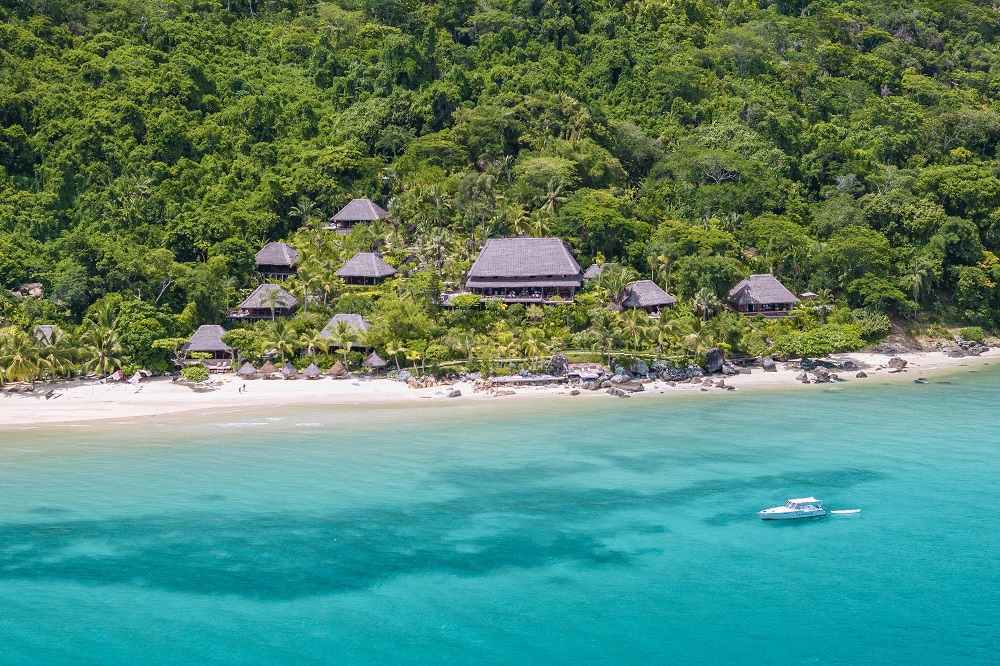
Activities
Activities at Tsara Komba start and end with swimming in the ocean off the beach right in front of the lodge. It is on the edge of a totally protected bay with no real waves to speak of. You can wade in as deep as you like without worrying about currents or riptides. Best of all: unlike many of the Kenya, Zanzibar and Mozambique beach resorts, it is possible to swim in the ocean here irrespective of the level of the tide and without having to wade half a mile to reach deeper water. One note of caution: there are some nasty-looking long-spined black sea urchins around so be careful where you step. Fortunately the water clarity is good enough to spot them before you step on them.
Hike up Nosy Komba island
It was 3 pm on a fairly hot day when our guide pointed up towards the peak of Nosy Komba island. “That’s where we’re headed, but not to worry, it will be ‘mora mora’ all the way. Mora mora, pole pole (in Malagasy and Swahili respectively) means slowly slowly. Which was just as well as this two hour hilly hike turned out to be more than moderately hard. I was expecting to see more in the way of local birds but that did not happen. It turned out that beyond the mature trees, much of the indigenous vegetation had been replaced with vanilla plantations, coffee plants, pepper vines, chocolate plants (cacao trees), jackfruit, and pineapple plants. The walk was quite steep up and rather challenging down, with lots of stepping onto and off rocks and other obstacles.
On the way back we walked through a village which had grown substantially since the Covid pandemic, with migrants from the mainland moving into the area for job opportunities. It was another good chance for close up views of the daily routine in a small coastal village. We observed inhabitants preparing dinner, enjoyed some interaction with a few children and checked out a couple of rudimentary grocery stores.
At the conclusion of the hike our Tsara Komba guide showed us his accommodation and a portion of the staff village. He also managed to coax a few beautiful black lemurs out of a very tall tree, with some judiciously dispensed bananas. The smaller males were rather reticent but I nonetheless managed several good captures.
Snorkeling on Nosy Tanikely
If there is one activity which we think all Tsara Komba guests should sign up for, it is snorkeling in the coral reefs just off the tiny island of Nosy Tanikely.
After a boat ride of about 25 minutes from the lodge, we walked onto the small beach at Nosy Tanikely which lies within sight of the main island of Nosy Be. For the first half hour or so, we scouted out the island – which is part of a marine national park – starting with taking a look at a mildly interesting natural history photo display. From there we took a path to a nearby lighthouse, one of several historical ones to be found all over Madagascar. We couldn’t resist making our way up to the top of the lighthouse while pondering the reason for the sign advising that only ten persons were allowed in the lighthouse simultaneously. Somehow I think the suspiciously rusty steps, dating back to 1908, have something to do with it. From the top, there are excellent views in practically every direction.
Two more reasons to visit Nosy Tanikely? It has a couple of species of introduced lemurs (we saw some of them high up in a tree) and there is a large colony of Madagascar giant fruit bats (flying foxes) in a tree not far from the shoreline. In the binoculars we could make out their shapes hanging upside down, like large dark avocados.
And then there is the snorkeling. In my life I had only experienced a few really entertaining snorkeling experiences, in the Cayman Islands decades ago and more recently in the Kona area of Hawaii.
The moment I stuck my face under the water at Tanikely, I realized that the snorkeling there was going to be special. And was it ever. Suddenly all around me was the most incredibly beautiful underwater ‘rock garden’ with a dazzling array of intricate, even stunning coral forms and patterns. From shelves that looked like giant flat mushrooms to tabletops to overgrown heads of cauliflower.
And literally everywhere the most jaw-dropping variety of fish one could ever imagine in a natural setting. There were huge schools of tiny fish which seemed to emit the most beautiful flashes of blue light as the sun reflected off their constantly moving, constantly shifting forms.
In other spots there were tightly packed schools of slender, substantially bigger fish to be seen, all seemingly moving as one as they instinctively maneuvered to evade the danger which my lumpy form no doubt represented.
Mostly though, the experience was one of constantly focusing and refocusing on different fish, from the most dainty angelfish to powerful looking specimens which kept a discreet distance.
There were a few misses or maybe also-rans in the activity list. To be clear this reflects my personal, subjective impressions of the activities. Other visitors may experience these in a totally different – hopefully more enjoyable – way. Also, this is not the conclusive list of Tsara Komba activities and outings. There are several more such as a day outing to Nosy Iranja (a renowned snorkeling area), discovering the botanical garden, scuba diving, snorkeling (sometimes with whale sharks in season), visiting Lokobe National Park, other fascinating island visits and more.
Local fishing outing
We went out with a couple of local fishermen one morning to try our luck with hand lines from a boat, fishing over a shallow reef about a kilometer out from the shoreline. It was largely a waste of time with the tiny fish mostly stealing the bait. I tried unsuccessfully a few times before quitting, when it became apparent that there were no good-sized fish around. Kathy brought in quite a few as did the Tsara Komba gardener, who is a keen amateur angler.
Sundowner cruise to the mangroves
A sundowner cruise to a nearby mangrove forest did not quite live up to its ‘romantic’ billing. Indian Ocean mangrove forests are by their very nature not the most exciting of habitats. Mostly just green. With just one or two species of trees and lots of leaves. So watching the regular green turn to vivid green in the late afternoon sun while sipping on a rum based cocktail (Kathy) or a Diet Pepsi (me) was not the most scintillating activity. I’d say skip it. If Tsara Komba wanted to improve the sundowner activity they can start with the snacks. We were hoping for something a bit more varied and exciting than some plain canned black olives. To be sure, It was mildly entertaining and – yes – romantic, watching the sun actually set on the slow boat ride back to the lodge. Just the two of us in the back of a boat, the golden light giving us back a few long-lost years.
Boat excursion around Nosy Komba
A last minute decision to do a boat ride around Nosy Komba island was interesting but not quite what we had in mind. I had envisaged a private boat outing with some opportunities to take impromptu, informal photos of village life and coastal scenes. Instead our skipper pretty much went full speed to the main village on Nosy Komba. Which I’m afraid is quite commercial with a lengthy walkway lined with vendors, terminating at the entrance to a lemur park. Where the local guide asked if we each wanted to hold a banana or piece of a banana which would have netted us a lemur on the shoulder. Of course, we demurred. Instead, I took a few pictures of two groups of black lemurs being lured quite close to us, the reward being pieces of said bananas. It was not our cup of tea. All in all I suppose feeding the lemurs for the benefit of gawking tourists is not the worst of sins. It’s just not what we travel to countries like Madagascar for.
In other respects the village was quite entertaining with (as usual) lots of kids around, women working in crafts, others having their hair braided, and quite a few people chewing khat, a natural plant source of methamphetamine. As Malagasy villages go, this one seemed a bit more organized and not as squalid as some we had seen elsewhere. Kathy thought many of the items for sale – such as the crocheted tablecloths- were worth closer scrutiny.
We were entreated to enter and tour a local museum but by that time our tourist chops had abandoned us and we skipped it. Maybe another time.
If you want to learn a bit more about getting to Tsara Komba and how to combine it with one or two other spots in Madagascar – or make it an add-on after or before a mainland Africa trip – email Bert at bert@fisheaglesafaris.com. Otherwise, please leave a message with our answering service by calling 1-800-513-5222 literally any time; someone will get back to you.
Madagascar East, West & North: June-July 2024 – Part 2
Kathy and I had no idea of what to expect on what turned out to be a fascinating visit of about 10 days to northern Madagascar, visiting places such as the Nosy Be archipelago, Ankarana National Park, Montagne D’Ambre National Park, the extraordinary Miavana island resort and ending with several days at Time & Tide’s Tsara Komba on Nosy Komba island.
To us, all of these places had hitherto just been points on a map, ill-conceived mental snapshots, much like rudimentary Al images. With very little resemblance to the vivid, warm reality which we experienced once we actually made it there.
Standouts? The beach at Tsara Komba, snorkeling at Nosy Tanikely, a forest walk at Montagne D’Ambre, a helicopter flight crisscrossing the area. And the food – everywhere.
Off to the north
Following on our all too brief stay at the superb Anjajavy Le Lodge on the west coast – read more in the blog post on our website – we returned to Tana. We spent the night at the perfectly fine if unremarkable Relais de Plateau hotel. Its two best features? A pretty good restaurant and being less than 10 minutes from Ivato airport. Our ebullient driver Mami drove us back the short distance to the rather dismal domestic terminal. On this day and earlier – on the wild ride to catch the flight to Anjajavy – Mami was a real asset to have around, helping us with luggage and getting us into the right line. Our next stop would be the well known northern Madagascar beach area of Nosy Be.
A night in Nosy Be
The Nosy Be archipelago has long attracted sun seekers, scuba divers and snorkeling enthusiasts from all over, notably France and lately Italy. With weekly flights on Neos Airlines from Milan and Rome, running into visitors from Italy in northern Madagascar is no coincidence.
From Tana, the flight duration to Nosy Be is a solid nine times shorter than from Milan. Only about one hour in an ATR operated by Cemair (for Madagascar Airlines). Unlike some of our other recent flights, this one was plain sailing with minimal fuss. It definitely helped to have paid extra for business class (for additional luggage) which provided access to a small airport lounge with some good coffee and a few bizarre breakfast food options. More importantly it resulted in us being waved through, while other passengers had their carry-on luggage weighed.
It took a good 45 minutes to get from the airport at Nosy Be to our hotel/resort – Ravintsara. To put it charitably, the property is a little past its prime but it has good-sized air conditioned rooms with a comfortable bed, mosquito net, a bath (one of those weird jacuzzi-like ones with jets) and a proper shower. The property has a noticeably lush garden and an exceptionally nice pool. The food was fine, with a more than respectable curried chicken with rice being one of the three options for dinner. The beach? Utterly forgettable, starting with difficult access down some steep, rough stone steps and a notable lack of white sand. There were several young couples relaxing on loungers under a row of palm trees on the edge of the beach. To be sure, some of them seemed to be having fun, but their smiles clearly had more to do with being in each other’s company than with the view, the beach or the setting.
The following morning we were driven to the port of Nosy Be. Following a hectic boarding process (of the type where you can’t keep track of your luggage) we stepped into a private speed boat transfer to the port of Ankify, on the mainland. And speedy it was, of the ‘hold on to your hat’ variety. From there, we drove – for the better part of the morning – in a northerly direction towards Ankarana National Park, close to which we would spend the following two nights.
Ankarana National Park
Iharana Bush Camp – where we spent just one instead of the two nights we had paid for – was a disappointment on several levels. We can handle rustic, but we’re beyond ‘primitive,’ so a room without proper windows or exterior doors which could be closed, was just not appealing. There was nowhere to sit and a fine layer of white dust coming down on everything was the last straw. Turned out they were sugar cane ashes. The room did have a pretty good shower head but alas, there was an issue with slow drainage. The veranda overlooking the small lake – with a pretty mountain in the background – was a nice spot to while away some time.
Iharana Bush Camp was too close to a nearby village and too far from Ankara National Park. It takes a solid 45 minutes to get to the main road (from Iharana) along a bone-jarring track and then it’s at least another 45 minutes to get to the park. Clearly the property had been badly impacted by a cyclone earlier in the year.
There were no issues with the only activity which we had time for, an outing on a small lake, during which we saw quite a few birds. Iharana Bush Camp also has a great view across the lake, with a pretty mountain with visible tsingy formations in the background. The lounge area was furnished and decorated in an interesting and creative manner. The staff members were friendly but not always present. The food was acceptable but nothing special.
We made it to Ankarana National Park at around 9:00 am. the following morning. A solid two hours later than I would have liked to be there. The park is mostly known for its particularly appealing tsingy rock formations – the so-called ‘tsingy rara’ – and for a mysterious natural sinkhole where three rivers disappear into what is in essence a natural bathtub, draining directly into the Indian Ocean about 12 miles away.
Tsingy is the Malagasy name for the country’s dramatic limestone karst rock formations, appearing like a forest of often razor-sharp shards. In Madagascar, there are three areas of tsingy popular with visitors. The largest is the Tsingy de Bemaraha in the western dry forests of the country. The other good example of tsingy can be found at Ankarana, where we were to see it up close at the terminal point of the forest walk.
The third area – known as the Red Tsingy – is also in the far north. While it superficially resembles real tsingy due its weird elongated shapes and spiky appearance, the red tsingy is not a limestone formation. It was caused by rain erosion on laterite. The red, or ‘false,’ tsingy is a much more recent phenomenon than ‘real’ tsingy which developed over millions of years. The erosion which exposed the red laterite tsingy-like structures is a modern-day phenomenon, being the result of environmental degradation caused by slash and burn agriculture.
With our energetic guide Simon showing the way, we strolled along a well maintained, easy trail under the dense canopy of the beautiful dry deciduous Ankarana forest. Right off the bat we saw three different kinds of lemurs, namely western gray bamboo lemur, red ruffed lemur and a couple of sleepy looking sportive lemurs which mostly rest up during the day and become active at night. These nocturnal creatures are insectivorous unlike the diurnal lemurs which are mostly plant eaters.
Unfortunately we did not have time to do a walk onto the tsingy and to cross the nearby hanging bridge. Our advice would be to spend two nights closer to the park than we did and make the most of at least one guided morning visit inside the park.
We spent the night at Ankarana Lodge, a 3.5 star lodge which is exceptionally well located for visits to Ankarana National Park, being less than five minutes from the gate. Our recommendation is to be there the moment the gate opens as that is when many of the forest dwellers are active: it is nice and cool and the light on the tsingy formations will no doubt be soft and pleasing. There were a few quirky things about Ankarana Lodge including the in-room air conditioning being available only from 8 pm to 10 pm. The excellent food and friendly staff made up for it though.
Money and credit cards
More than once we forgot that credit cards are not widely accepted everywhere in Madagascar – this happened at both Iharana Bush Camp and Ankarana Lodge. Not only would they not accept our credit cards: our cash US dollars were no good either. It was Malagasy ariary or Euros and nothing else. Which caused an uncomfortable situation for us when we were literally down to our last few Malagasy ariary and had to borrow some cash from our guide Bruno. It worked out fine in the end but prospective visitors need to keep it in mind. Carry plenty of cash with you, and have some ‘emergency Euros’ in your back pocket. You never know when they may come into play.
Driving from Ankarana to Diego Suarez
The drive from Ankarana along the main south-north highway – the RN2 – was yet another microcosm of Madagascar. The vestiges of the beautiful landscapes and forests are still there but they barely shine through among the grim reality of decades of deforestation. What was once virgin forest is now small farms or large sugar cane plantations, and it is impossible to overlook the alien vegetation including the ubiquitous eucalyptus trees.
All along the way, in a seemingly never-ending pattern, we would pass one small village after another with rudimentary small homes, shacks and other structures just meters from the edge of the road. Along this road, it was difficult not to observe the squalor associated with grinding poverty. Clearly, life is hard in rural Madagascar but fortunately we did not see any obvious signs of malnutrition. In fact all the many toddlers and children we observed seemed to be well-fed and healthy. The staple food of Madagascar is rice, and it – together with beans, cassava, corn, peas, spring onions and sweet potatoes – is widely cultivated on the small farms which are found all over the countryside.
Along the north road, the entrepreneurial spirit was very much in evidence. There were vendors everywhere. Some work from good sized covered structures in side-alley bazaars, their shops brimming with wares ranging from charcoal braziers to fresh produce, rice, beans and other foodstuffs, all the way to colorful garments of every shape and size. Others, mostly solo operators, had just a table and a couple of baskets. With preciously few items for sale. Often just a handful of tomatoes, some onions or bananas or maybe some menakely, the local version of donuts. I tried my best to convince our guide Bruno to let me try the road-side treats but without success. Probably just as well.
Once or twice along the way, we stopped for photos and despite the language barrier it was easy to quickly establish trust and engender just enough confidence on the part of the locals for a snapshot. In fact, one of the most frustrating parts of the road trip portion of our Madagascar journey was driving past dozens of photo opportunities. So if you are keen on mixing it up with the locals, by all means plan on exploring some of the byways and hidden highlights associated with the human experience. Just be sure to adjust your schedule to provide for some time and where possible, some pre planned stops.
Almost everywhere, and more so in the rural areas, there were startlingly large numbers of babies, toddlers and young children to be seen, indicative of one of Madagascar’s other challenges. Largely unchecked population growth. The statistics tell the story.
Madagascar’s rapid population growth has the country on a path to reach nearly 51 million total population within the next 25 years. An increase of a whopping 70% over the current 30 million. This is the result of only slowly decreasing fertility rates combined with increases in life expectancy. Further contributing to rapid natural population growth is Madagascar’s exceptionally young demographic profile, with 40% of the total population being under 15 years old. In time, urbanization and education will further decrease the rate of population growth. Until then, many more millions of Malagasy will join the ranks of people living under the poverty line.
Red Tsingy
On our way from Ankarana to Antsiranana (Diego Suarez) the following day, we took a detour to the so-called red or ‘false’ tsingy formations. My initial reaction to seeing the famous red tsingy was less than enthusiastic. It appeared to have been damaged by a recent cyclone with some of the red cones having fallen over and one or two areas being partially obliterated by shifting mud.
However, as our guide Bruno and I walked further up the ravine – to which the red tsingy is confined – the views kept getting better. By far the best spot was close to the viewing platform under a tree, quite high up in the ravine. Pretty much surrounding the viewing platform, these strange – practically orange – protrusions lend a surreal atmosphere to the place, turning it into what could easily be mistaken for some long lost corner of Mars.
The red tsingy are laterite rock formations, uncovered by erosion in a canyon, a process which was accelerated by runoff caused by deforestation. All starting with the ‘slash and burn’ activity when local farmers cut down and burned portions of the forest to create grazing areas for their zebu cattle.
After the pretty strenuous hike – in bright sunshine – we stopped for lunch at a local family enterprise where local dishes such as wild boar with rice and a starter of crab and avocado salad were served. It was excellent. Just like elsewhere in Madagascar there was no Zero or Diet Coke but I gladly settled for YouZou. A bit like Sprite but not as sweet; you’ll just have to try it for yourself sometime.
Montagne D’Ambre National Park
Our next stop was the port city of Antsiranana for two things: to get some much needed Madagascar ariary from an ATM and to buy some good quality Madagascar vanilla from a local source. Then it was 45 minutes or so on a truly awful road to our next stop: Nature Lodge, a simple, delightful thatched property with 12 chalets, all with nice if somewhat distant views over the ocean. We liked everything about this property: the setting, good food, great all round hospitality, comfortable, well equipped rooms and close to Montagne D’Ambre National Park. The park, the oldest one of its kind in Madagascar, is known for its gorgeous forest with massive trees, small lakes and several ‘sacred’ waterfalls. The park is home to several interesting bird species as well as a couple of lemur species. For serious birdwatchers we’d recommend two morning outings into the park as forest birding is always challenging and often impacted by wind or other factors. Just be sure to start as early as possible. Our local forest guide Regas was knowledgeable and affable.
A helicopter flight to Miavana
At the security checkpoint at Diego Suarez’ tiny airport we – and every piece of our luggage – were intensively scrutinized, to the extent of being patted down and checked with a handheld metal detector. The airport bureaucrats once again demonstrated a severe lack of common sense. Once everyone there was convinced that we were not a pair of grey-haired, wild-eyed fanatics intent on creating havoc involving mostly ourselves, we were allowed to board our aircraft. Much to our delight, it was Miavana’s recently acquired Airbus 135, a 7-seat helicopter which got us across to the island resort in the utmost of style and comfort. About as quiet and stable an experience flying in a helicopter as one could imagine. The Airbus helicopter can take up to 6 passengers with one pilot or 5 passengers with 2 pilots. It is a state-of-the-art machine in every way. Along the way en route to Miavana, beyond ‘just’ the gorgeous scenery and various shades of blue ocean, there were several other points of interest to observe and objects to photograph from the air. Most notably, a particularly nice stand of the locally endemic Adansonia perrieri, a highly threatened species of baobab. Kathy also spotted a large sea turtle swimming in the clear ocean water – much to her delight.
Behind the controls of the helicopter was Hein Brittz, Time & Tide’s chief pilot. Hein has been with Miavana from the very beginning, since 2014, and has acquired extensive experience and expertise flying and traveling all over the island and beyond. When not flying, Hein is a keen fly-fisher and he knows where and when several sought-after species like giant trevally can be caught – and released. He knows the waters around the island like the back of his hand. Clearly a natural at any island adventure, Hein makes the perfect guide to this extraordinary place he calls home. We found Hein to be super friendly and enthusiastic and would have liked to have spent more time with him.
On both our chopper flights – from Diego Suarez to Miavana and later from there clear across Northern Madagascar to Nosy Be, I was fortunate to get to occupy the co-pilot seat in front. In both the Airbus and Miavana’s other chopper – the really nice turbine Robinson 66 – this seat has practically unobscured views to the front and below. Using a Nikon 70-200 zoom lens at 1,000th of a second shutter release speed and a focal length of f-8 I managed a few decent exposures despite some pretty hazy conditions.
A valuable piece of advice from Hein was for confirmed guests to pre-book a couple of helicopter outings – catering to their specific interests – even before arriving at Miavana. By the time guests realize – on the flight from Diego Suarez to Miavana – just how exhilarating and rewarding flight-seeing by helicopter is, it may already be too late to book an outing of their choice, particularly on a stay of just a few days.
Miavana Resort
Miavana resort is gorgeous and beyond beautiful and impressive with 14 massive villas ranging from one to three bedrooms with as much space as anyone could possibly desire, with views to boot.
Clearly, Miavana is the ultimate in luxury and self-indulgence, the kind of place where celebrities come to escape the paparazzi. We certainly felt special, being welcomed by Damian Goncalves-Jardine, assistant general manager and whisked off by electric cart for a poolside lunch.
Our tapas lunch was straight out of a romance novel with swaying palm trees, a cool breeze, and mesmerizing views over the ocean, about as far away as a soft toss of a small coconut.
Miavana does not do anything half-heartedly as we quickly realized, having ordered two tapas items each, which seemed like a reasonable thing to do. The portions were huge but the freshly prepared shellfish and other items were so delicious, we managed.
While Kathy enjoyed a massage I checked out the villa, a beautifully designed edifice with literally everything you could want ranging from a king size plus bed, his and her sinks, a huge bathtub, a separate toilet, indoor and outdoor shower, a kitchenette with fridge, coffee maker, a selection of premier wines and beverages and an abundant buffet of snacks. If your favorite wasn’t there, you could request it.
Each villa has its own electric buggy and bikes to get around the island and to make your way to and from the main building.

Activities at Miavana
Our short inspection visit to Miavana provided us with a good overall impression of the setting and the beauty of the area. What we didn’t have time for were the many activities which include scuba diving, snorkeling, fishing, boating, paddle boarding, kayaking, kiteboarding, island tours, lemur trekking, nature walks, turtle monitoring, birdwatching, tree planting, spending time at the gym, the ‘cabinet de curiosities’ and at the well-stocked boutique. There’s more: spa treatments which cover a range of luxurious massages, facials, body treatments and finishing touches, as well as Ayurvedic treatments and yoga classes.
Several extraordinary national parks are just a short helicopter flight away from Miavana on the Madagascar mainland. Accompanied by one of their knowledgeable guides, you can explore the region’s rare wildlife, remarkable landscapes and fascinating natural history. Destinations include Daraina (Tattersall’s Camp), Anjahakely (Black Lemur Camp), Ankarana National Park, Tsingy Rouge, Baobab forests and secluded sundowner spots. Or tailor-make your own scenic flight adventure.
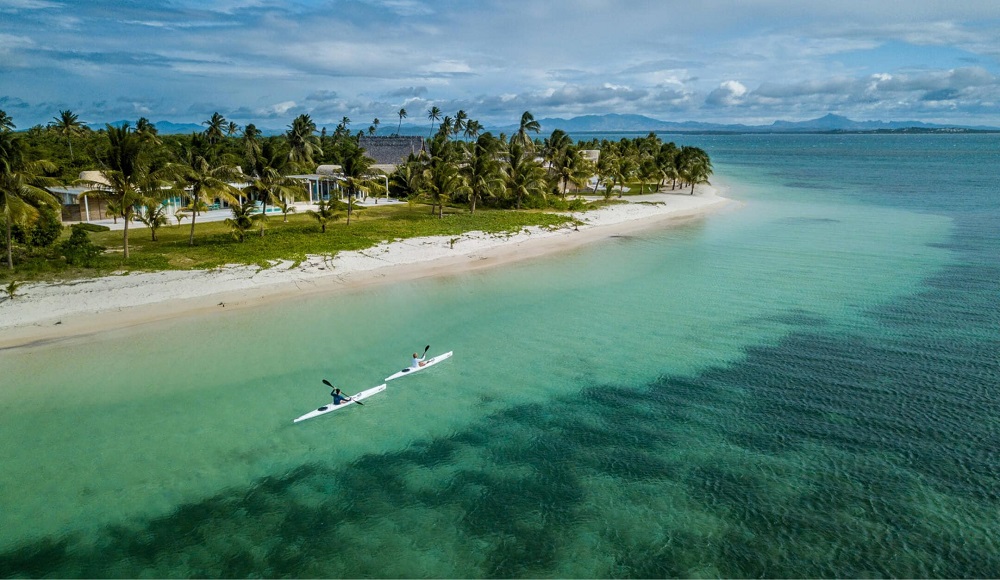
Miavana for children
Miavana is the ultimate playground for children, offering activities tailored to each child’s age and interests. Little island explorers can adventure across land and sea, learning about the environment as well as from different members of the team. Enriching, inspiring, and importantly – fun. Some popular kids activities at Miavana include PADI Bubblemaker & Discover Scuba Diving, snorkeling, fishing, watersports, swimming, treasure hunts, chameleon challenge, and scavenger hunts. Beyond those there are opportunities for Malagasy face painting and other cultural experiences, as well as other active pursuits like bike riding, buggy license and guided quad biking. Children can embark on turtle walks, lemur treks, and participate in tree planting. They can play beach volleyball, cricket, soccer, and table tennis. Miavana has lots of outlets for their creativity such as sand castle making, coconut painting, Madagascan animal mask making, beading and other crafts. For the budding chefs there’s pizza making, cookie baking and cupcake decoration.
Our last few days in Madagascar were spent at Tsara Komba, a small luxury resort hidden away at the base of the east-facing slope of Nosy Komba, the second biggest island in the Nosy Be archipelago.
Read the blog post about our stay at Tsara Komba here.
Madagascar itineraries
We have developed a couple of new itineraries for Madagascar which will enable visitors to optimize their stay and not waste too much time on the road. The two itineraries are for the eastern montane rainforests (Andasibe-Mantadia area, mostly lemur-focused) and for the north (Montagne D’Ambre, Ankarana Forest and Nosy Komba) where the experience will be a mix of nature exploration and wildlife observation, with forest hiking, lemur observation, snorkeling and ending with several days at a premier beach resort.
Either of the two itineraries can be extended with excursions to one of these areas:
- Anjajavy Le Lodge on the northwestern coast in dry deciduous forest habitat
- Tsara Komba resort, tucked away in a secluded spot on Nosy Komba island, in the northern Nosy Be Archipelago
- The wild and exciting Masoala Peninsula on the northeastern coast
For recommendations about visiting Madagascar, email Bert at bert@fisheaglesafaris.com or call our Houston office at 1-800 513-5222 any time.

Lyndon Visits Matusadona National Park, Lake Kariba
Visitors from North America rarely make it to either Lake Kariba or Matusadona National Park in Zimbabwe, which is too bad. Combined with Victoria Falls and either Hwange or Mana Pools, Lake Kariba adds yet another layer of diversity to the already absorbing Zimbabwean experience. Boat safaris, tiger fishing, lake cruises, foot safaris, birdwatching and now even a sleepout on a luxury yacht will keep you occupied and will provide a nice change of pace from game drives.
Bumi Hills Lodge
Leaving for Bumi Hills from Victoria Falls in May this year, we were in the smaller Cessna 206 which flies pretty low so we were able to get some good views of Kariba on the approach. From the Bumi Hills airstrip it is a very short distance to get to camp – maybe 10 minutes. We met our guide Max on arrival in camp. The lodge is gorgeous with spectacular views of the lake and the surrounding floodplains. You can see elephants from the main area – they look tiny.
Bumi Hills Lodge has numerous activities on offer including game drives and walks as well as a boat cruise or fishing – or most likely a combination. There is a spa available as well as a 24/7 fitness center. A village visit was also mentioned if guests want to do it. We suggest that it be requested in advance. The main area at Bumi Hills has an infinity pool, likely the best one on the lake. Many a gaze has been directed over the lake from this elevated spot with the pool having been around for decades; the original Bumi Hills Safari Lodge opened in 1975.
The rooms are as nice as you would expect. All with great views, plenty of space, complete with bath and outdoor shower. African Bush Camps offer essentially a room attendant as well as a personal host to take care of your every need. I really do feel like they work well together and enable you to get the most out of your stay.
Our evening game drive was productive. I did not expect to see the quantity of animals that we did, gathered in the open areas near the lake. Tons of impala as well as zebra, bushbuck, warthogs, and elephants, as well as bird species in high numbers. Sunset was beautiful – even beyond the normally enthralling African sunset. On the way back to camp with the spotlight, we saw a white-tailed mongoose and side-striped jackal. Porcupines live underneath the camp and the staff pointed them out to us just before dinner.
The food was good at Bumi Hills. Lunch was a ‘build your own pizza’ and for dinner we had the choice of lamb chops or stuffed chicken. Of course we both went with lamb. It was good; but Bert’s has it beat by a good margin.
For the morning activity we decided to go fishing. We were looking for bream and vundu (a large variety of catfish) because it is really not a great season for tiger fish. Our first spot was close to where the boat was docked. The area did not seem like it was very active and we quickly moved on. The second spot was another story and we started reeling in bream constantly. They are good fun and while we caught them our guide Max threw out a different line to see if he could snag a vundu. That line finally hit and Christine managed to pull in our first catfish. It was sizable but the species can grow much larger. We are hoping to take another shot at landing a whopper at Changa.
In the afternoon Christine had an hour massage scheduled and while she was busy with that I took a swim in the infinity pool. Simply spectacular views out onto the lake and the water was the perfect temperature. Great place to spend an afternoon!! After this we enjoyed a quick lunch before heading back to the room.
Our evening activity was a sundowner cruise. This time we went with four other people. We started quite late, around 4:00. It took us a little while but we sped out to a spot in the middle of a large number of long dead mopane trees, dating back to when the dam was built in the late 1950s. Around us all types of birds – but predominantly cormorants – were roosting for the night. No predators out here for them in the tall dead trees. The sunset was top notch but overall the activity felt a bit rushed and while it was nice I would only do it the one time.
Nights at Bumi are pretty because you get to see all the commercial boats out on the lake with their lights fishing for small sardine-like fish called kapenta. The boats do not move and use lights to attract the fish to their nets and then periodically lift them. They can do this a total of 4 times give or take during a night. They will then let the fish dry during the day and package them for sale. All the fishermen pay to obtain a license to fish in the lake and it seems like the populations of the different species of fish are being fairly well maintained. With all the lights it looks almost like a floating city and with the elevated views from the lodge it is quite a scene.
Dinner was two delicious curry options, beef or chicken. Dessert was a fabulous passionfruit panna cotta.
Changa Camp
The following morning our flight to Changa was quite early so we just had breakfast before being transferred to the airstrip. We then had a 15-to-20-minute flight to Changa’s airstrip followed by a 25–30-minute transfer to camp. We spotted two huge male buffalo mudbathing as we landed. We met our guide Crispen on arrival. Changa is located inside the Matusadona National Park, unlike Bumi Hills, which is adjacent to it on community land. It is right on the edge of the floodplain overlooking Lake Kariba. A similar variety of activities are offered at both camps.
I spent a bit of the afternoon in the pool in the main area. The water temperature was cold but very refreshing. I was joined in the distance by a solitary elephant and a hippo that decided to get a head start on dinner. Christine spotted a snake near the restroom, but it slithered off before I could get a look at it. The camp manager had told us that snakes are around but that 99 percent were not venomous.
For our first evening we chose to go take a look at Sanyati Gorge (45 minute to an hour boat ride). It was worthwhile and I would recommend it. The gorge is scenic, very rocky with tall hills surrounding it and lush forests and plants surrounding you. You will see a lot of crocs so if that is something you are interested in this is just the ticket. We ended the activity with a sundowner at the lake before heading back to camp.
Changa is more rustic than Bumi for sure but has its own charm. The main area is a bit sparse but there is a pool and you have a good view of the lake. The rooms are nicer than I was imagining they would be. Outdoor bath and shower available.
For dinner we had pork belly and it was really good. Dessert was a caramel panna cotta. Activities are decided on during dinner the night before. So we decided at dinner that we would like to do an early morning game drive with a packed lunch.
Morning wake up was at 5:30. Coffee was delivered to the room along with some breakfast rusks. We set off with a packed breakfast to make the most of the cooler morning temperatures. The drive started off slowly as we saw only the occasional antelope, warthog or baboon. Things started picking up as we got a bit further from camp and we started spotting elephants with some regularity as well as zebras which were recently semi-reintroduced by African Parks. Their numbers had been decimated before due to a large lion population and although they were still around their numbers had dwindled. African Parks took over Matusadona in 2019 and have started implementing new conservation practices such as strictly enforcing anti-poaching and reintroducing species that have previously been wiped out.
Speaking of lions, their numbers have also fallen. When the lake floods many of the prey animals wind up starving to death which is a boon in the short term but long term it forces the lions to rely on hunting hippo or even crocodiles. Their numbers are increasing now though with the plentiful availability of prey species. In fact there is a pride of over 20 lions in the park that have a territory from Changa all the way to the border, the Tshinga River.
One of the highlights was spotting a leopard tortoise hastily making its way across the road. It turtled up when we approached but Crispen turned off the engine and after a little while you could see the head peeking out and sure enough the arms and legs followed. It started to move again but at a much slower pace than before. These guys can live between 250 to 300 years! Assuming they don’t run into the right predator, that is.
By late May the area was still green and there was plenty of food and even water dispersed in the thick bushy areas. This made game viewing tough but as the water dries up and the food gets eaten all of the animals will start to congregate around the lake which should make for a spectacular sight. Even before the dry season had properly set in, there were large herds of antelope and zebra as well as families of elephants at the shoreline or feeding in the floodplains. This year the later stages of the dry season will be especially tough because there was not a lot of rain. The water level of the whole lake is low and it has not been at full capacity since 2013. Hopefully they receive more rain in the coming years.
For our evening activity we tried our luck with some fishing. This activity gets started a little bit later than others so that the winds die down and the lake becomes still. We only had to travel a short while from the camp’s dock to get to our fishing spot. Things started slowly but picked up after the first fish. We wound up with a couple of good-sized bream as well as several ‘squeakers’ which seem to be an invasive species. They look like a type of small catfish with a vicious set of spines that can even be dangerous for crocodiles to eat. We enjoyed a sundowner before heading back to camp.
The following morning we woke up at 5:30am for a game drive. We were out of camp by around 6. Temperatures are cooler in the mornings but not exceptionally so. By midday it got up to the mid 80s. Again we had no luck with predators but enjoyed some marvelous landscapes and plenty of plains game and elephants. As the numbers of plains game continue to increase you can expect a slow increase in the predators as well. As the season continues and the availability of water becomes more scarce the animals will really start to congregate around the lake making for some epic scenes. June and July should bring more moderate temperatures but it will still be drying by September, October and November which could be extraordinary. Albeit possibly at the cost of your sanity with some real extreme heat. Such is life on safari.
Lyndon is ready to answer any questions you may have about visiting the Matusadona National Park area in Zimbabwe, as well as Hwange and Victoria Falls. He can be reached at lyndon@fisheaglesafaris.com or by calling our office any time (irrespective of your time zone) at 1-800-513-5222. Lyndon or Jason will call you back.
Madagascar Resort of the Month: Anjajavy Le Lodge, Northwestern Madagascar Coast
I first became aware of Anjajavy some years ago at a travel industry event in Cape Town and a visit to the resort had slowly percolated to the top of our ‘must-visit’ list. Reflecting upon our all too short visit there, I regret that we had not made it to Anjajavy sooner. It is a jewel of a spot, as good as it gets on many levels starting with location (remote and isolated), setting (gorgeous) and hospitality in the wider sense, reflecting service, food and ambiance. All impeccable.
There is only one way to get to Anjajavy and it is by scheduled charter flight from Tana; the flight currently operates four times per week. There is a minimum stay requirement of three nights but I would urge prospective visitors to spend five nights at Anjajavy. It is one of the most isolated spots in western Madagascar with a Robinson Crusoe-esque feel. Several times while walking on the beautiful beach in front of the lodge, Kathy and I felt like the only people around. Of course, with the exception of a few British guests and a French family, we were. The experience there is not to be rushed so by all means stay as long as you can.
It was quite windy on the day we arrived and we found out that a stiff breeze is very much part of the experience at Anjajavy. We stopped noticing it within just hours, our attention shifting to all the other things which make Anjajavy the special place that it is. Besides being windy, it was dry and sunny, the complete opposite from the rainy, dreary eastern rainforests which we had just come from. The way to the lodge was a dusty but well-maintained track; a drive of about 20 minutes. En route, we drove through patches of open savanna habitat which was oddly reminiscent of mainland Africa. A few zebras and giraffes would not have been out of place in this dry deciduous forest habitat.
My first impression at Anjajavy was one of space and light, with pretty views over the ocean enhanced by some attractive palm trees and a large pool surrounded by unopened umbrellas, green lawns and tiled walkways. Not a thing was out of place. The main complex is dominated by an extensive indoor/outdoor dining room which encompasses a bar and boutique. Spend a few days there and you will soon find your own favorite spot for the al fresco meals.
Kathy and I thought the rooms at Anjajavy were just right. Properly air-conditioned, they were by no means huge but perfectly adequate size-wise, with a queen-sized bed with mosquito net, a breakfast area with table and chairs, a small separate bathroom with shower, a separate enclosed toilet with small sink, sliding doors which opened to a deck with chairs and a hammock, and an upstairs room with an additional double bed. The steps up to the upstairs bedroom are scarily steep so buyer beware. It would be ok for the kids but not for grandma.
As we found out right away, the food was superb. With Anjajavy being an accredited Relais & Chateaux property, I suppose that was to be expected, at least to some degree. Even so, we made the most of the extensive number of choices for all meals, with a range of local and international dishes – mostly French inspired – on offer. Everything was fresh, with much of the produce and other items sourced locally.
A word of caution: the walkways between the rooms and the main lodge are uneven with (too) many elevation changes. At night, making your way to and back from the dining area could be a potentially hazardous experience, with inadequate lighting and no rails. So be careful and use a good flashlight.
A quirky thing about Anjajavy is that it operates on its own ‘island’ time zone which is one hour ahead (later) than regular Madagascar time. So guests have to manually adjust their smartphones and watches. Guests are told about this on arrival. I never did quite figure out why the lodge adopted this practice; it seems to serve the same purpose as daylight savings in the US, which is to move the hours of human activity to make the best use of available daylight. Anjajavy is pronounced just like it is written, but the last ‘y’ letter is silent. So if you say it like ‘an-jah-JAHV’ you will sound just like a local. Or close.
Activities at Anjajavy
Anjajavy has a beautiful beach with a small and apparently safe demarcated swimming area. Before doing anything else, we spent a little while wading into the cool, crystal clear water of the Indian Ocean. It felt great. Just like at Tsara Komba which we would get to a bit later on our trip, the ocean in front of Anjajavy was swimmable irrespective of the status of the tide. Each of the ocean-view rooms has its own private umbrella and beach loungers, reached by a set of wooden steps down from the elevated rooms.
Mangrove forest sundowners
That afternoon we tagged along with three other guests on an outing by boat into a large stand of mangroves, which line the river. The mangroves – beyond several other functions which include providing a nursery area for many fish and crustacean species – also protect the area from severe damage during cyclones. On the excursion we saw a few interesting birds including dimorphic egret, Madagascar buzzard, malachite kingfisher, Madagascar bee eaters and – from a long distance away – a colony of flying foxes.
We crammed a lot into our full day at Anjajavy: an early morning birding outing, checking out the Madagascar giant tortoise rewilding project, and a boating excursion to Moramba Bay. The birding was good, and the fact that I didn’t get quite as many usable bird photos as I had anticipated was totally on me trying to figure out the autofocus on a new mirrorless camera. Maybe not the time and place for it.
Giant Madagascar tortoise rewilding project
Kathy and I were both fascinated by Anjajavy’s Madagascar giant tortoise project. Since its inception – starting off in 2018 with 12 adult giant tortoises which had been poached and then confiscated by the authorities – the project has grown by leaps and bounds. To date, more than 150 baby tortoises have hatched and are being protected in the tortoise nursery in Anjajavy. They will be returned to the wild once they are ready. The juvenile tortoises are being raised in an environment very similar to the one they will be freed into, so that they develop the foraging skills they will need to survive in the wild. The project aims to have 500 wild giant tortoises in Anjajavy Reserve by 2030 and about 2,000 by 2040. Considering that these enormous animals have been locally extinct in Madagascar for 500 years, this is groundbreaking work.
Speed boat outing to Moramba Bay
Our speed boat trip to the beautiful Moramba Bay area culminated with a sighting of a Madagascar fish eagle, a bird which we had long wanted to add to our life list. It is disheartening to know that there are only about 100 pairs of these very special birds still present in Madagascar. The bay produced several other highlights, not the least of which was seeing four or five stands of beautiful baobabs growing in limestone formations. Moramba Bay is about as photogenic a place as one could find anywhere and we could easily have spent several additional hours there. And would have liked to. Maybe with a picnic lunch somewhere or snorkeling around one of the limestone islets. Next time.
Afternoon tea with the sifakas
An activity not to be missed is the afternoon tea in a large clearing – also known as the oasis – in Anjajavy’s beautiful garden. Almost every afternoon around 5 to 6 pm ‘island time,’ a small troop of Coquerel’s sifaka adds a dash of verve and excitement to what would be a perfectly fine afternoon tea without them. Jumping seemingly effortlessly and even languidly from one branch or tree to another, they make it easy for visitors to conclude that they had made a wise choice to spend a few days here at the literal end of the world. A bonus? Spotting one or two small groups of common brown lemurs lagging behind the limelight-stealing sifakas. In their own way the brown lemurs are just as interesting.
Anjajavy – just go!
As I mentioned earlier, Anjajavy can only be reached by scheduled charter flights (and not every day of the week) from Antananarivo; there is a minimum stay requirement and it is not inexpensive, particularly if you figure in the cost of the many optional (pricey) excursions.
Even so, once you get there – and I urge everyone to do so at the first, best opportunity – you will observe the leaping Coquerel’s sifakas in the garden and think, “I should have done this sooner.”
Anjajavy Le Lodge is Madagascar redux, with lemurs, beaches, baobabs, tsingy rock formations and fascinating culture. All in one place. Beyond that you’ll experience gorgeous sunsets, sublime food and a team of lodge staff and guides delivering an all round resort experience which compares with some of the best in the world, at an affordable price point.
Anjajavy truly has it all. Location, remoteness and an ideal mix of activities. It also felt as if the team there was truly motivated to help guests experience the property and the reserve in the best possible way. Even though we spent only two nights there, we were treated to a romantic dinner in the garden on our last night. It was just perfect, ending with a plaintive song performed by six team members – a lead singer, guitarist and mini drum player and three chorus members. All working together so well, helping us create an indelible memory. In fact, all our experiences at Anjajavy contributed to a unique set of memories.
First and foremost Anjajavy is a conservation project. Manager Frederic Massoubre was proud to point out that he employs a large squad of people who have no line function in and around the lodge itself. All their efforts are devoted exclusively to maintaining the habitat and wildlife in the adjoining protected area.
The negatives? The WiFi is super slow but really this is one place where you should actively try to disconnect and reconnect with nature. There’s every opportunity for it. Also, come prepared with a wide-open wallet as there is a limited range of ‘free’ activities at Anjajavy. Unless of course your idea of a resort stay is to mostly chill by the pool and in the ocean, and enjoy afternoon tea with the sifakas. For active guests, particularly those who like to hike, there are as many as eight or nine different trails to explore, either on self-guided or guided basis. Free water activities include kayaks, windsurfing, catamaran outings and snorkeling.
Everything else is going to cost you pretty dearly, ranging from 50 Euro per person for a morning birding outing to E125 per person for a half day boating outing to Moramba Bay. Our recommendation is to pre-pay a package of activities, currently about $750 per person for a boat excursion with picnic lunch to Moramba Bay, a vehicle excursion to Antafiamoara village and the giant tortoise project, and three guided land activities: a night walk, a village visit and a bird-watching outing.
Things which we didn’t get to do include mountain biking, exploring a cave with extinct giant lemur fossils, a village visit and spending time at the pool. If you’re really into physical fitness, I think mountain biking around the reserve could be fun. It’s going to be hard with so much sand about, as will running. Comforting thought: there are no elephants or buffaloes around. Unlike mainland Africa, Madagascar has no scary large hairy mammals lurking behind bushes so go ahead and jog with your favorite tunes in your headphones.
If you want to learn a bit more about getting to Anjajavy and how to possibly combine it with one or two other spots in Madagascar – or make it an add-on after or before a mainland Africa trip – email Bert at bert@fisheaglesafaris.com. Otherwise, please leave a message with our answering service by calling 1-800-513-5222 literally any time; someone will get back to you.





